G2 Goldfields (TSXV:GTWO) has announced results from ongoing drilling at its OKO gold project. The company has intersected a new surface zone of broad disseminated gold mineralization and mechanical trenching over 500m to the north of the new drill intersection. The trenching has exposed a new wide zone of stockwork-style mineralization within similar host rocks, and G2 has observed large amounts of free gold in pan concentrates.
The results come from the 19,200-acre OKO gold project and have the potential to add near-surface gold resources to the initial maiden resource estimate announced in April for OKO Main Zone. Both discoveries are located between OMZ and Reunion Gold’s OKO West discovery, and are hosted within magnetite-rich metamorphic host rocks, that are identical to those at Reunion Gold’s Block 4 discovery. G2 is still exploring this area with two excavators and two drills.
Dan Noone, G2 Goldfields CEO, commented in a press release: “This recent work has demonstrated the tremendous prospectivity of the ground between OMZ and Reunion. These latest discoveries are potential game changers for our Company, and we look forward to executing an aggressive results-focussed program for our investors.”
Results from the drilling are as follows:
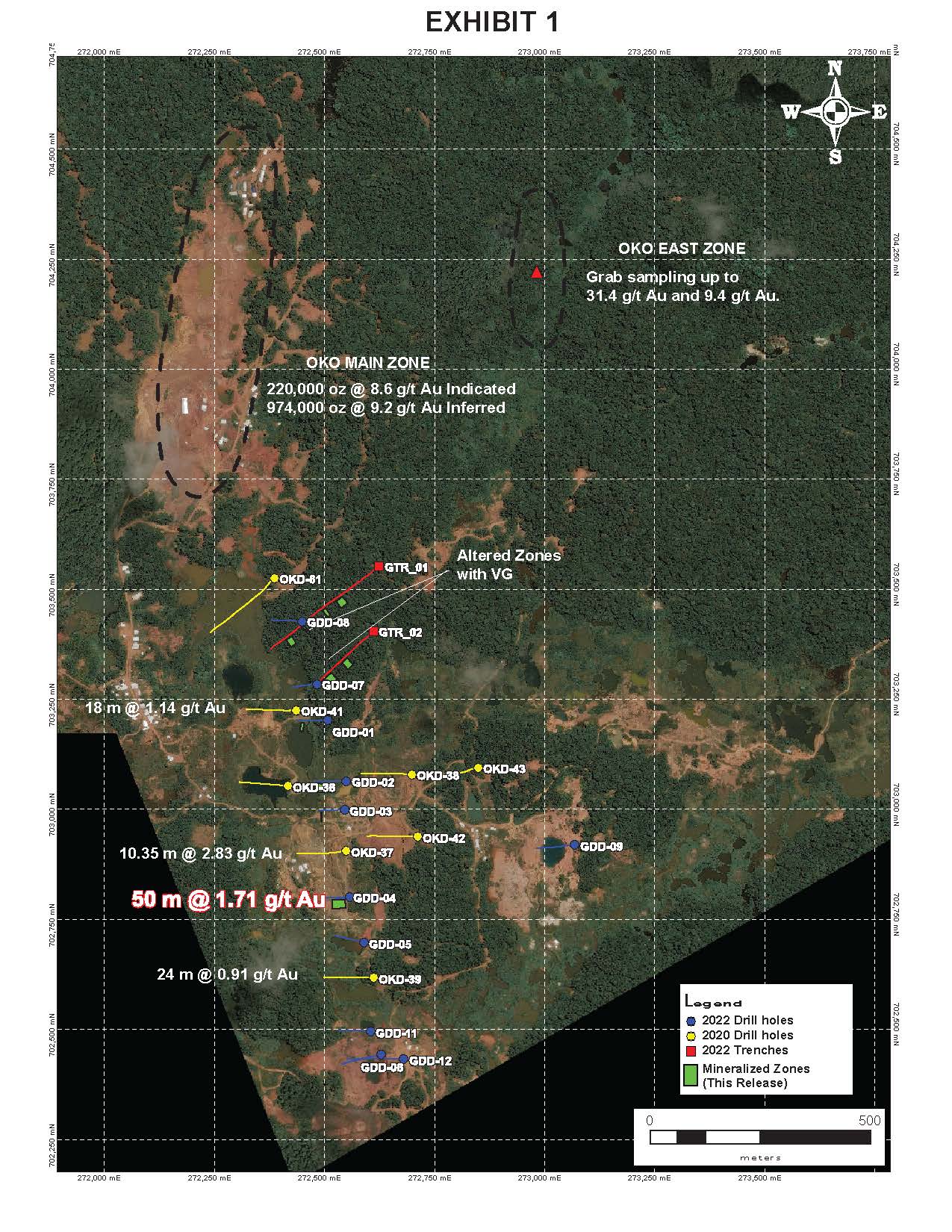
Drilling and trenching targeted a newly defined 1.2 km long zone of anomalous gold in soils and saprolite. Previous drilling in 2020 & 2021 (OMZ series holes on Exhibit 1), although encountering intriguing intercepts, appears to have missed most of the zones encountered in the current program. Generally, the previous holes were collared too far to the west, and thus drilled into the intrusion rather than the main shear.
In the current program, twelve diamond drill holes (totalling 1,356 m) and two excavator trenches (totalling 495 m) have been completed. Assays are currently available for the first four holes. Results are tabulated below.
TABLE 1
Hole ID From To Int (m) Au g/t
GDD-01 96.00 108.50 12.50 0.91
GDD-02 95.00 116.00 21.00 1.01
GDD-03 90.00 93.00 3.00 1.74
GDD-04 21.00 71.00 50.00 1.71
Incl. 55.50 69.40 13.90 5.09
Significant intervals in this press release have been calculated using a grade cutoff of 0.3 g/t Au and up to 10 meters maximum length of internal waste. Included significant intervals have been calculated using a grade cutoff of 1.0 g/t Au, a minimum length of three meters, and up to three meters maximum length of internal waste. Gold grades are uncapped. Mineralized intersection lengths are not necessarily true widths.
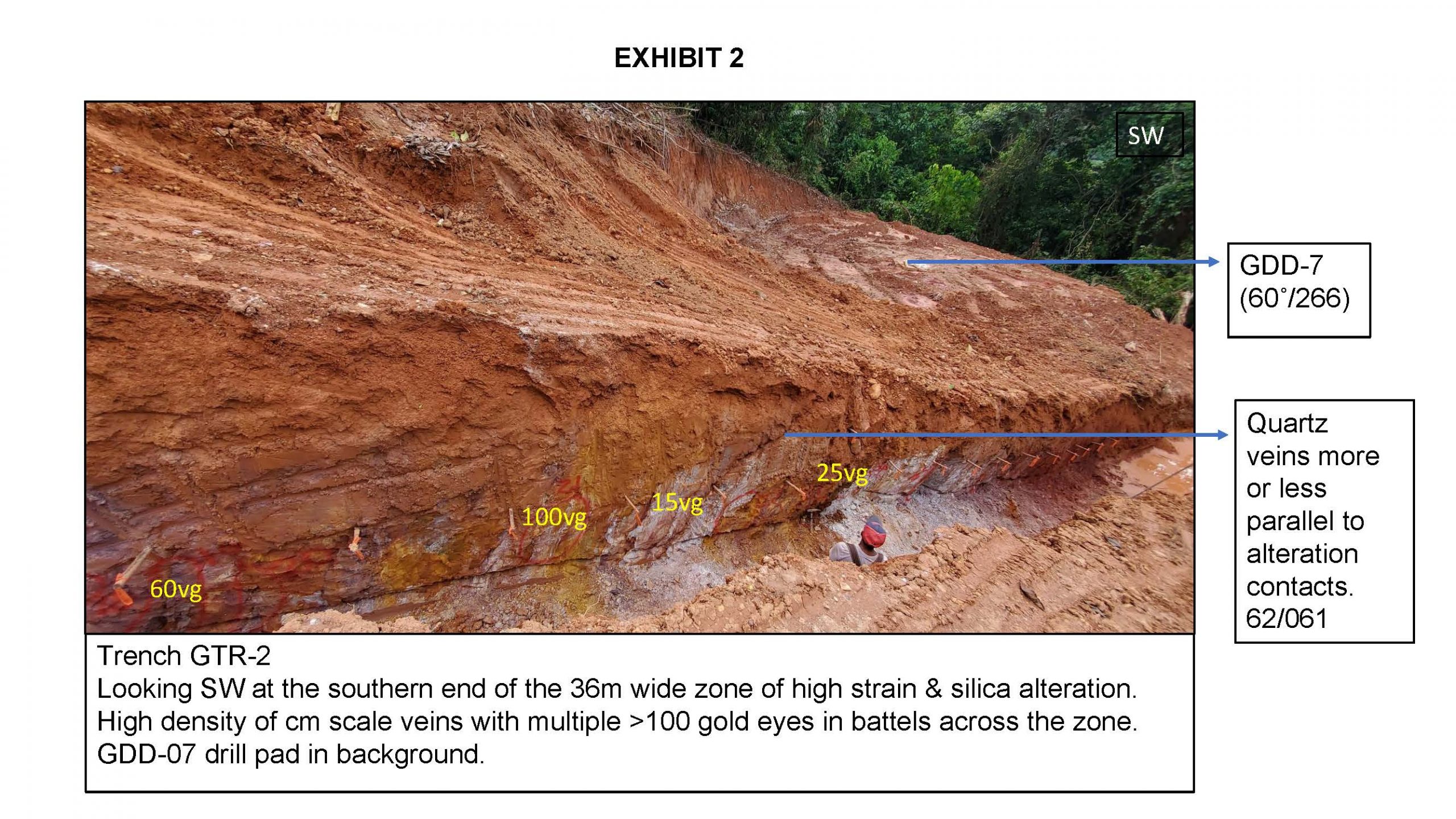
These initial four holes define a zone of interest open to both the north and the south with a strike length of 400m. The intercept of 50m @ 1.71 g/t Au in GDD-04 is hosted by a high-strain zone within a magnetite rich metamorphic host rock. Multiple centimetre-scale quartz carbonate veins, that occasionally have visible gold are complementary to the selective replacement of magnetite by pyrite along vein selvages and sometimes disseminated over broad zones within the host rock.
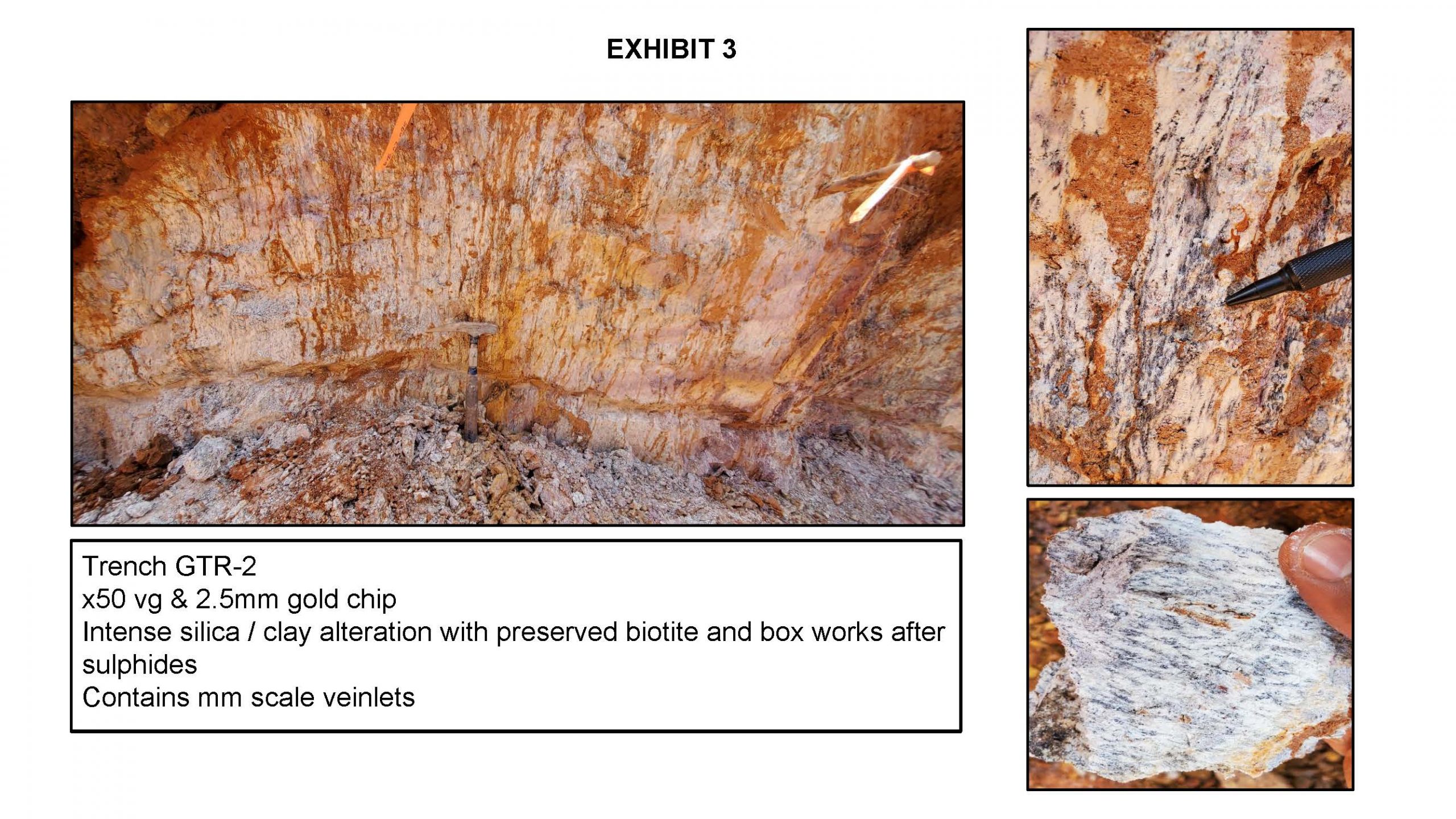
The style of mineralization within the magnetite rich host rock is identical to Reunion Gold’s Block 4 discovery which occurs within the same high-strain corridor another 1.2 km along strike from the intercept in GDD-04.
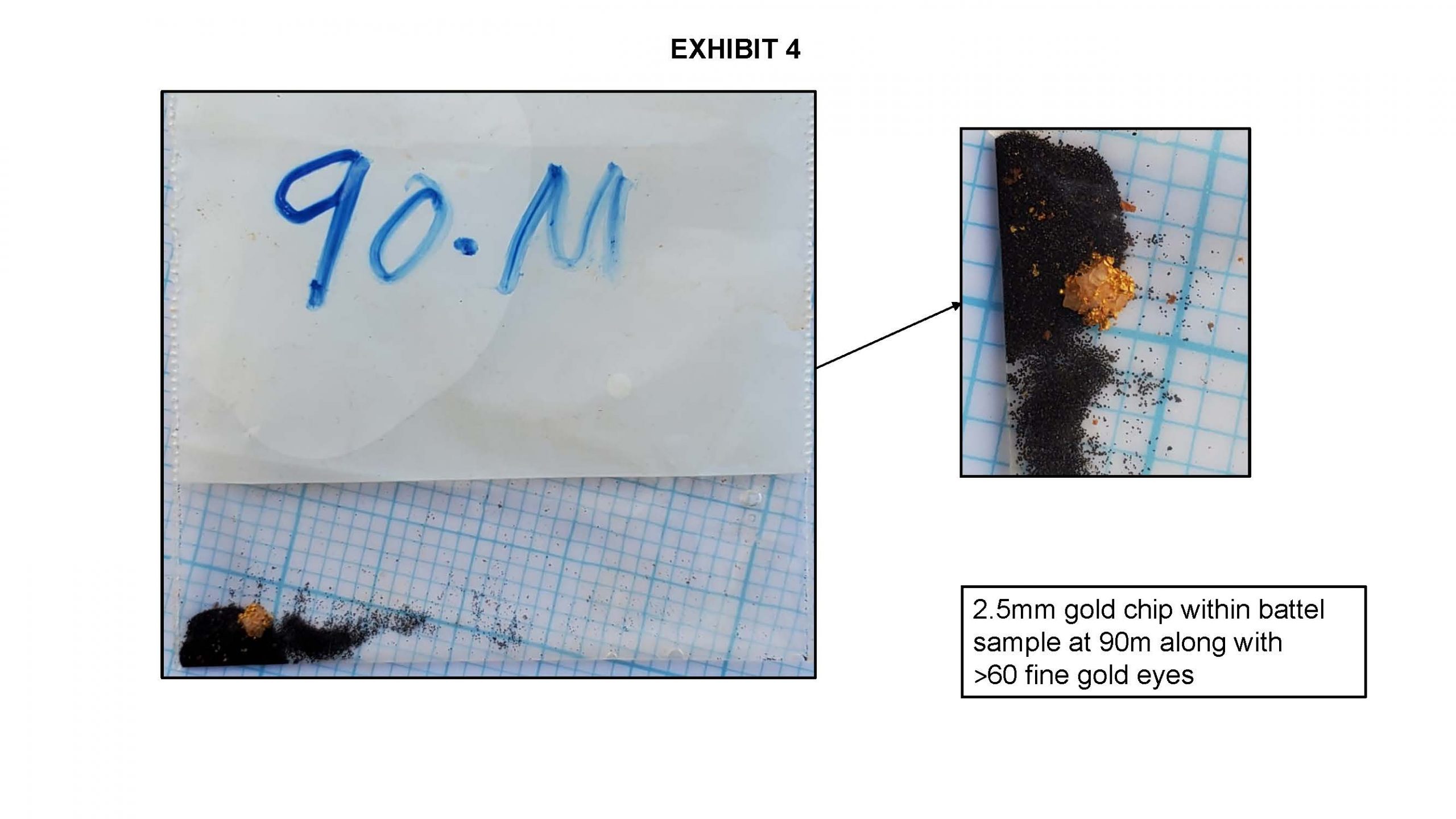
Trenching Exposes Quartz Stockworks
G2 has completed two trenches (GTR1, GTR2 see Exhibit 1) approximately 500m north of hole GDD-04. These trenches have exposed extensive auriferous stockwork zones of 49 m in GTR1 and 36 m in GTR2. Photographs of these stockworks are shown below as Exhibits 2 and 3. Continuous channel samples from the trenches have been submitted for assaying. G2 also sampled additional material for panning and manual gold eye counts using a hand lens. Some of the samples have provided over 200 gold “eyes” as well as the discovery of coarse gold particulate Exhibit 4.
The above references an opinion and is for information purposes only. It is not intended to be investment advice. Seek a licensed professional for investment advice. The author is not an insider or shareholder of any of the companies mentioned above.
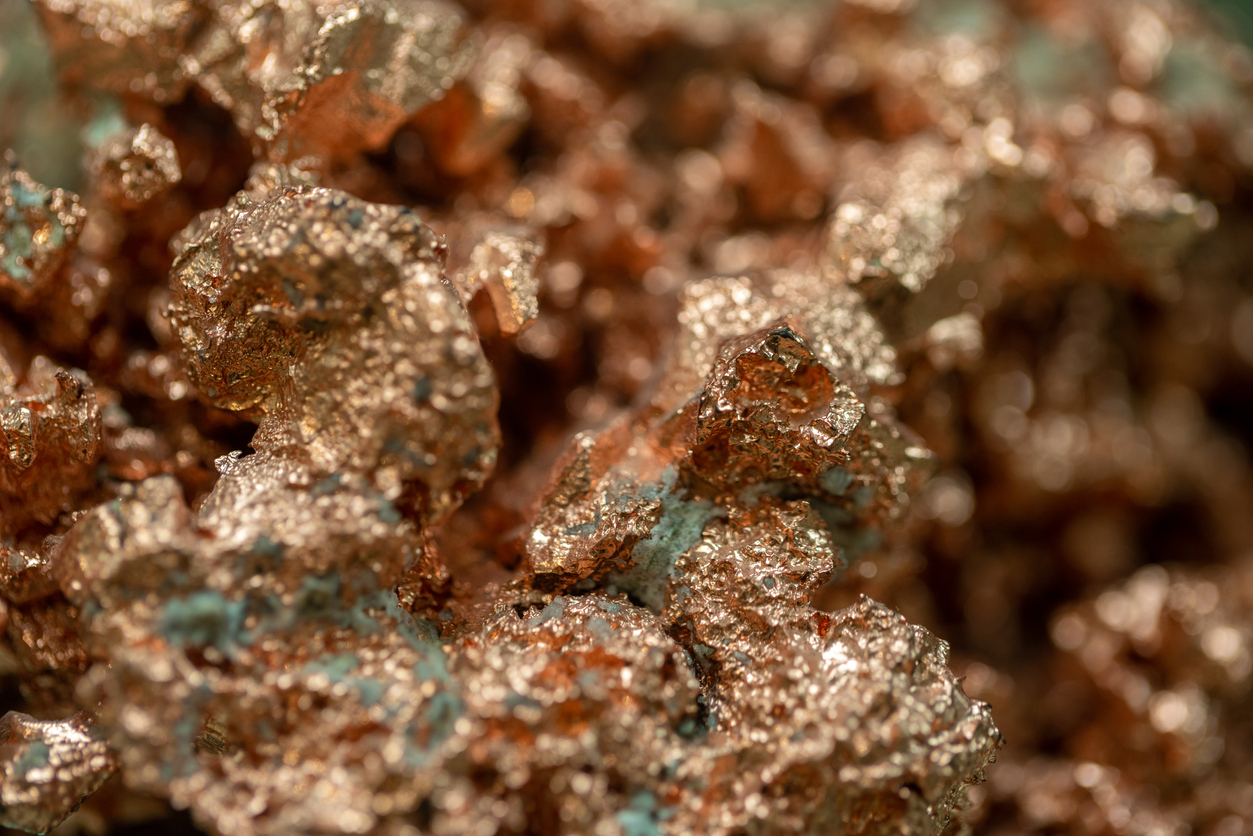
The mining sector has put itself in a difficult position, underinvesting in new copper projects when copper demand is rising. The good news for those looking for a copper investment is that there are still a number of new copper projects in the works.
One of these projects is the Warintza copper project in southeastern Ecuador. Warintza is a world-class large-scale resource with expansion and discovery potential. There have been four major discoveries since the project started and the Mineral Resource Estimate at the project has been expanded from earlier in 2022. Most recently, Canadian mining company Solaris Resources (TSX:SLS) (OTCQB:SLSSF), which owns Warintza, reported new assay results from a series of holes aimed at delineating resources at the Warintza East discovery.
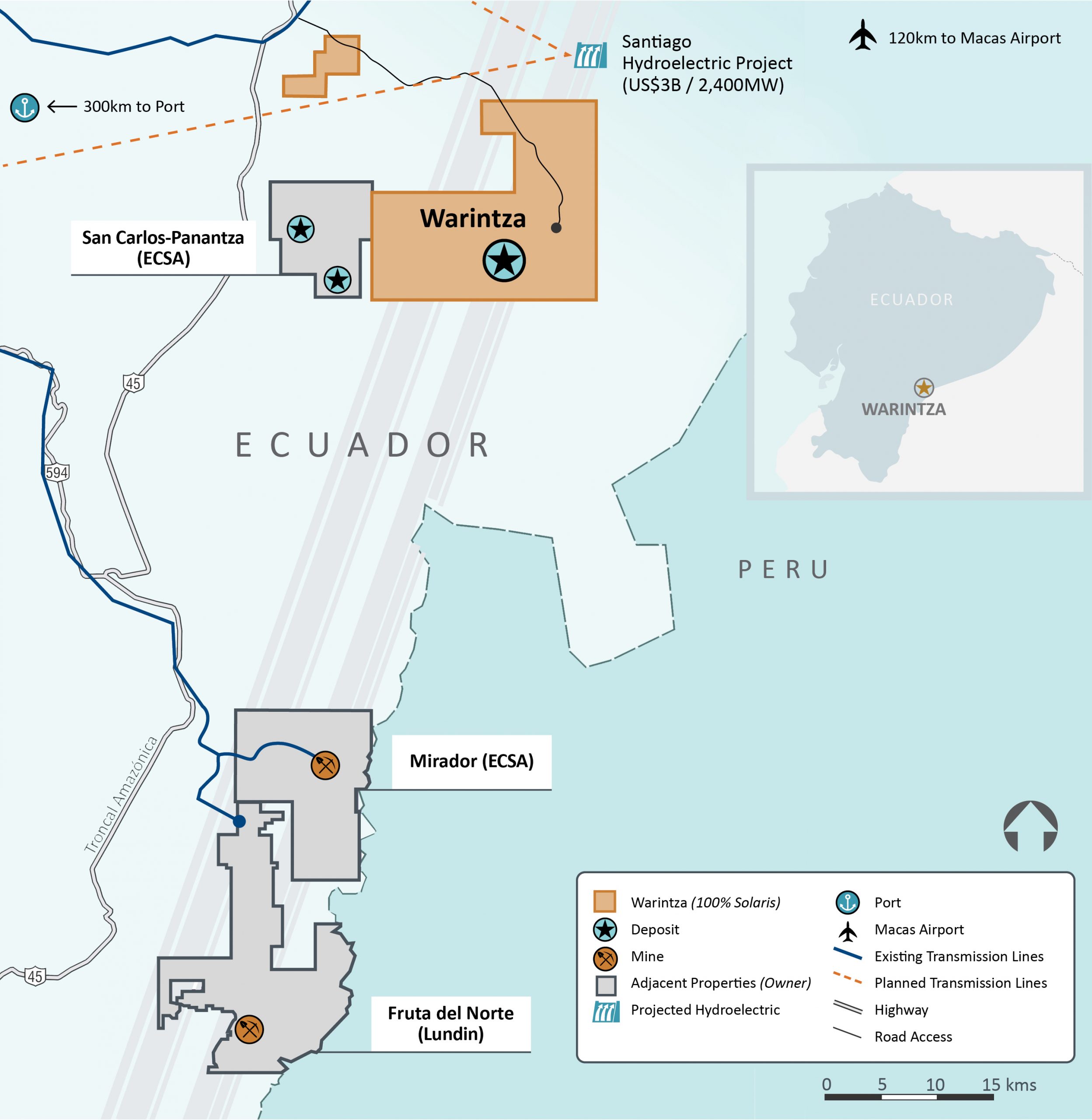
Highlights from the results are as follows:
Warintza East was discovered in July 2021, with eight holes covering the overlapping periphery included in the Warintza Central Mineral Resource Estimate (“MRE”)¹ in April 2022. These follow-up drilling results significantly expand the drilled dimensions of the Warintza East footprint to the east and southwest, with the deposit remaining entirely open towards strong soil anomalism to the northeast and southeast.
- SLSE-15 was collared in the middle of the Warintza East grid and drilled east into a partially open volume, returning 204m of 0.60% CuEq² within a broader interval of 910m of 0.40% CuEq² from near surface, extending mineralization to the east where it remains open
- SLSE-14, stepped out approximately 250m from the eastern limit of the grid and drilled northwest into an open volume, returning 292m of 0.50% CuEq² within a broader interval of 694m of 0.40% CuEq² from near surface, extending mineralization in this direction where it remains open
- SLSE-12 was collared at the eastern limit of the grid and drilled southwest into an open volume, returning 48m of 0.53% CuEq² within a broader interval of 508m of 0.40% CuEq² from surface, extending mineralization in this direction
- SLSE-13 was collared from the same platform and drilled southwest into an open volume, returning 104m of 0.45% CuEq² within a broader interval of 618m of 0.29% CuEq² from surface, expanding the footprint to the south where it remains open
- SLSE-10 and SLSE-11 were collared in the overlapping portion with Warintza Central and drilled northwest into partially open volumes, returning 282m of 0.53% CuEq² and 270m of 0.55% CuEq², respectively, within broader intervals from near surface
- Drilling to date confirms Warintza East as a significant porphyry deposit which remains open for expansion in multiple areas, with assays pending from a series of extensional holes to the northeast, east and south
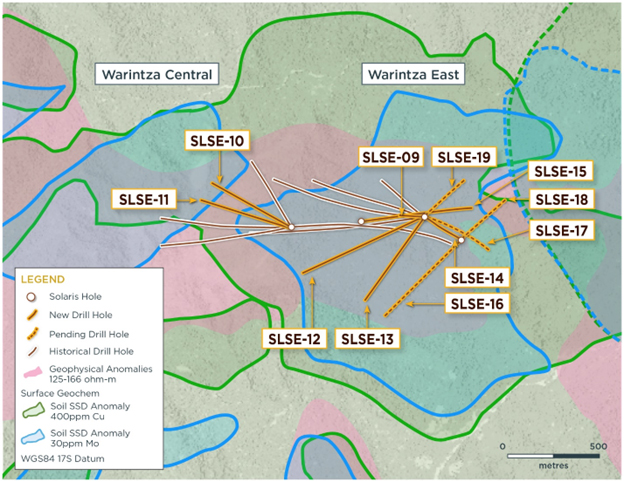
Warintza stands out in an environment where under-investment in new copper mines and exploration is jeopardizing the metal-intensive energy transition. Massive amounts of copper will be needed for everything from electric vehicles to renewable energy infrastructure.
Companies have instead focused on expanding mines with stronger guarantees of shareholder returns, playing it safe, but in turn, neglecting to invest in new projects. This focus on short-term shareholder returns and paying out dividends or using cash for share buybacks has left the discoveries to junior mining companies that are developing some of the most promising projects in the world. New copper mines take decades to achieve commercial production, and only exploration being done at projects right now has a chance of coming online in time for it to make a difference for future production levels.
Additionally, new discoveries have typically been of lower grades, making the Warintza Project an exceptional outlier in an environment when alarms are sounding for supply and demand dynamics. Lower grades ultimately make the copper more expensive to extract, but the potential for the high-grade “superpit” at Warintza is exactly what companies are looking for.
The future of copper is bright, but only if we see more investments in new projects like Warintza. Solaris Resources is one of the few mining companies that is making such investments, and the prospects for the Warintza project look very promising.
The above references an opinion and is for information purposes only. It is not intended to be investment advice. Seek a licensed professional for investment advice. The author is not an insider or shareholder of any of the companies mentioned above.
Azucar Minerals (TSXV:AMZ) has reported new drill results from the two holes completed into the large lithocap target from the press release dated March 10, 2022. The two holes pass through typical clay-dominant lithocap alteration into phyllic alteration.
At both holes, large intervals of brecciated rock were intersected which could reflect a diatreme-like body. This could have disputed earlier porphyry alteration zonation in this area. All of the alteration data was collected from the core using a Terraspec infrared spectrometer with the samples for assay. The company did not intersect any significant intervals of porphyry mineralisation but the second hole did intersect a late sulphide vein that returned 0.70 metres of 0.95% copper and 0.42 g/t gold.
The company is not assessing how to explore the lithocap target further along with other zones and will provide another update once this review is complete.
J.D. Poliquin, Chairman of Azucar Minerals commented in a press release: “These two holes were the first to be drilled into this newly defined alteration target. It is important to remind shareholders that this zone is one of many porphyry targets and centres on the project. We have defined a preliminary resource on the most explored Norte Zone, and we intend to continue our exploration on this project to further unlock the potential of the multiple zones and targets which are yet to be fully tested.”
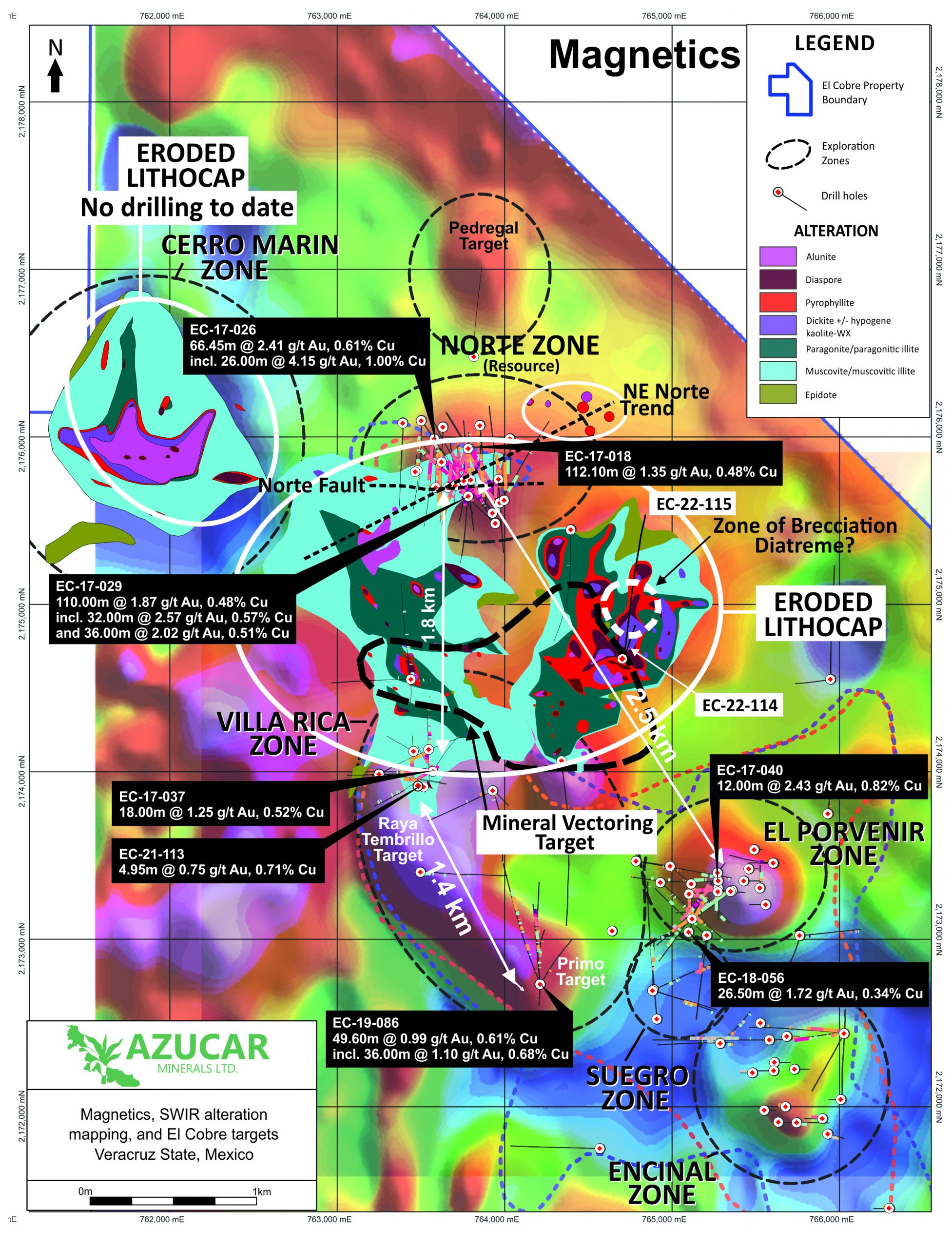
Norte Zone
| Hole | From (m) | To (m) | Interval (m) | Au (g/t) | Cu (%) |
| EC-17-018 | 222.40 | 334.50 | 112.10 | 1.35 | 0.48 |
| EC-17-026 | 543.45 | 609.90 | 66.45 | 2.41 | 0.61 |
| Including | 543.45 | 569.45 | 26.00 | 4.15 | 1.00 |
| EC-17-029 | 204.15 | 314.15 | 110.00 | 1.87 | 0.48 |
| Including | 208.15 | 240.15 | 32.00 | 2.57 | 0.57 |
| and | 264.15 | 300.15 | 36.00 | 2.02 | 0.51 |
Raya Tembrillo (1.8km South of Norte)
| Hole | From (m) | To (m) | Interval (m) | Au (g/t) | Cu (%) |
| EC-17-037 | 302.00 | 320.00 | 18.00 | 1.25 | 0.52 |
Primo Zone (1.4km South of Raya Tembrillo)
| Hole | From (m) | To (m) | Interval (m) | Au (g/t) | Cu (%) |
| EC-19-086 | 868.40 | 918.00 | 49.60 | 0.99 | 0.61 |
| Including | 878.40 | 914.40 | 36.00 | 1.10 | 0.68 |
Porvenir Zone (2.5 km SE of Norte, 1.0 km west of Primo
| Hole | From (m) | To (m) | Interval (m) | Au (g/t) | Cu (%) |
| EC-17-040 | 243.00 | 255.00 | 12.00 | 2.43 | 0.82 |
| EC-18-056 | 381.50 | 408.00 | 26.50 | 1.72 | 0.34 |
The above references an opinion and is for information purposes only. It is not intended to be investment advice. Seek a licensed professional for investment advice. The author is not an insider or shareholder of any of the companies mentioned above.
Thesis Gold (TSXV:TAU) has provided an update on the recent assay results from its 2022 summer drill program from the Ridge zone at the Ranch Gold Project in British Columbia, Canada. The company has received results with broad mineralization and a high success ratio of drilling at the site, with 75% of the results for the holes still to be received.
Ewan Webster, President and CEO, commented in a press release: “The early assay results that we have received from the Bonanza-Ridge zone continue to deliver robust intervals of broad mineralization, demonstrating continuity along strike and at depth. The success ratio of drilling so far this season has been exceptional and over 75% of holes have yet to be received.”
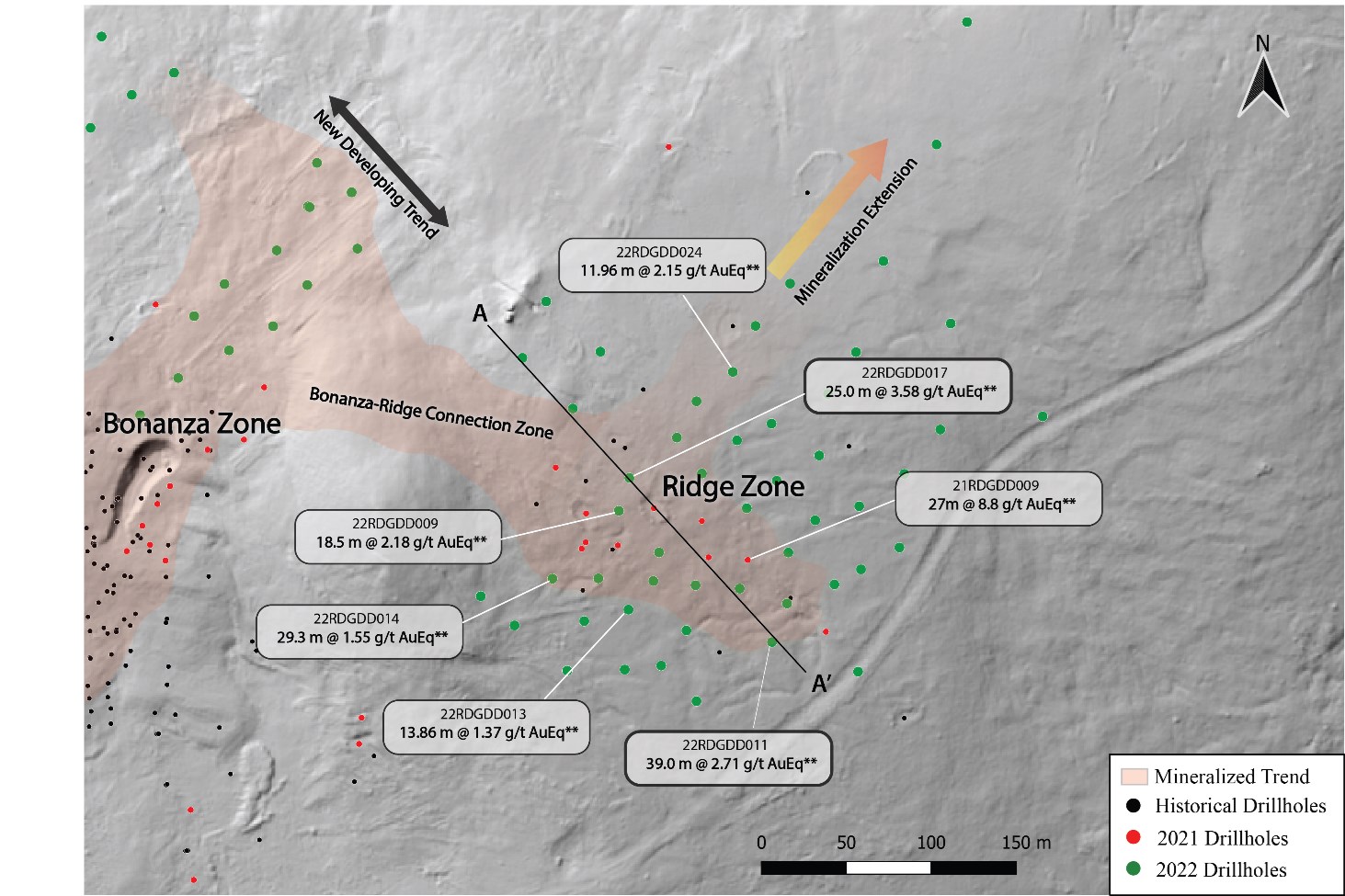
Highlights from the updated results are as follows:
- Ridge hole 22RDGDD011 returned 39.00 metres (m) core length of 2.56 grams per tonne (g/t) gold (Au), 11.99 g/t silver (Ag) or 2.71 g/t AuEq** (Table 1), including 32.00 m of 2.97 g/t Au, 13.75 g/t Ag or 3.14 g/t AuEq (Table 1, Figures 1&2)
- Ridge hole 22RDGDD017 returned 25.00 m of 3.22 g/t Au, 28.78 Ag or 3.58 g/t AuEq, including 6.00 m of 7.26 g/t Au, 4.15 g/t Ag, or 7.94 g/t AuEq (Table 1, Figure 1)
- These positive drill results represent significant mineralized intersections demonstrating the continued expansion of the mineralized domains along dominant northwest and northeast oriented structures within the broader mineralizing system at the Bonanza-Ridge zones.
- Drillhole 22RDGDD011 tested the depth extent of mineralization and confirmed continuity along broad scale fault structures that transect the Ridge Zone, mineralization remains open along strike and at depth.
- Drillholes 22RDGDD009 & 017 intersected significant mineralization between the Ridge and Bonanza zones. Adjacent Bonanza drillholes 22BNZDD016 & 018 (pending assay results, Figure 2) intersected significant near surface, vuggy silica zones typically closely associated with mineralization at the Bonanza-Ridge zones.
- The majority of initial assay results from the 2022 drill program have delivered strong, consistent intervals of significant mineralization.
Early-stage results from the step out drill campaign at the Ridge Zone have expanded the mineralized domain(s) and provided essential geological context which will be integrated into future expansion programs. Drillholes 22RDGDD013 & 24 (Figure 1) occur on the southern and northern extents of the Ridge Zone and were part of a larger step out drilling program at the Ridge Zone designed to test the extent of mineralization along the NE oriented fault structure. Drillholes 22RDG0011 & 17 tested the SE and SW extents (Figures 1&2) of the Ridge Zone and successfully delivered broad zones of mineralization, with 22RDGDD011 further expanding the SE extent of known mineralization, and 22RDGDD017 helping infill the gap between the mineralized domains of the northern extent of the Bonanza Zone, and the southern extent of the Ridge Zone (Figure 2).
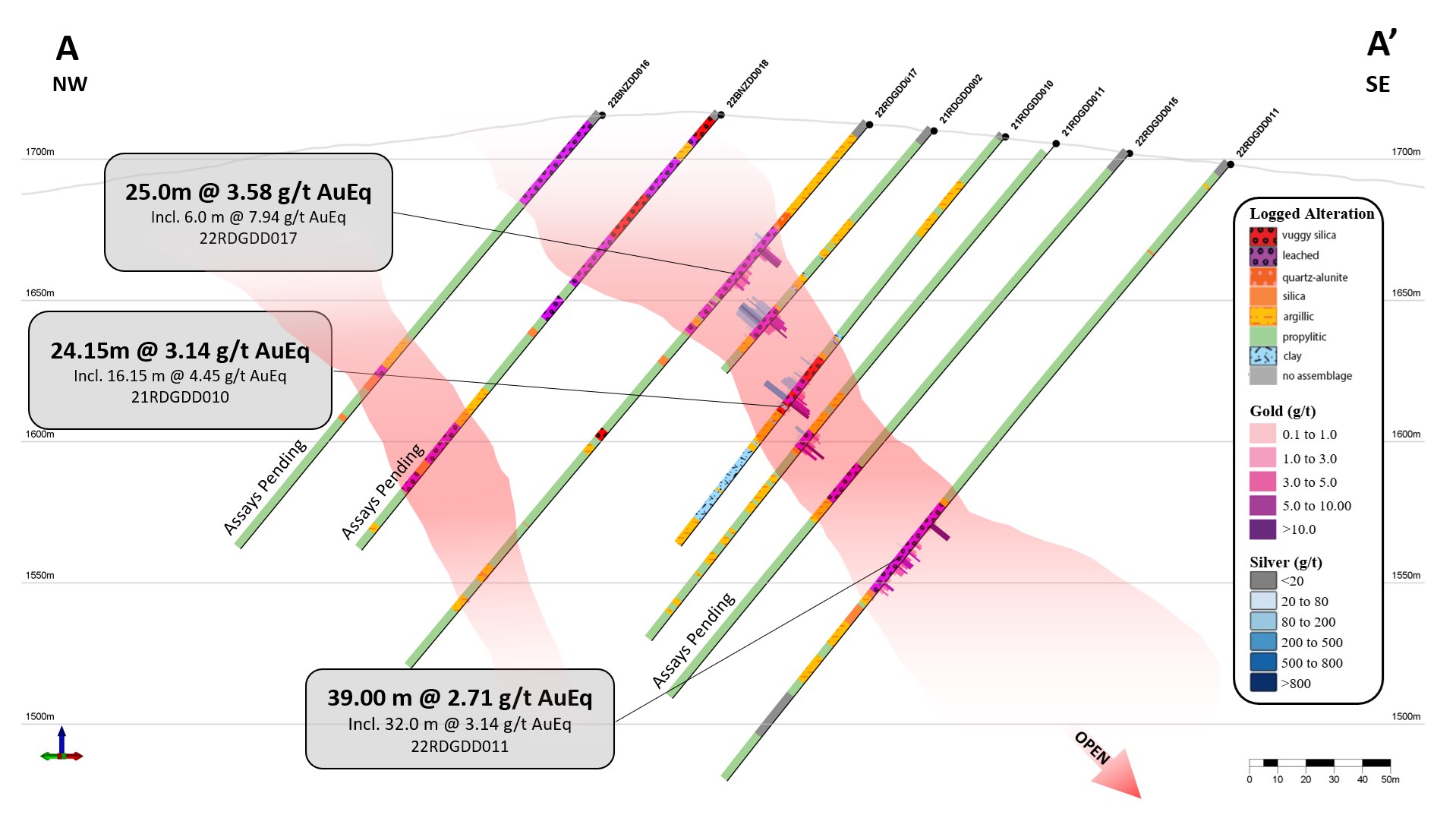
Table 1: Assay Results from the Ridge Zone
| Drillhole | From | To | Interval | Au (g/t) | Ag (ppm) | AuEq | Zone | |
| 22RDGDD007 | 188.31 | 201.00 | 12.69 | 1.31 | 7.14 | 1.40 | Ridge | |
| incl. | 188.31 | 191.07 | 2.76 | 5.66 | 22.35 | 5.94 | ||
| 22RDGDD009 | 67.22 | 85.72 | 18.50 | 1.85 | 26.42 | 2.18 | Ridge | |
| incl. | 70.00 | 82.00 | 12.00 | 2.63 | 26.83 | 2.97 | ||
| 22RDGDD011 | 161.00 | 200.00 | 39.00 | 2.56 | 11.99 | 2.71 | Ridge | |
| incl. | 164.00 | 196.00 | 32.00 | 2.97 | 13.75 | 3.14 | ||
| and incl. | 164.00 | 170.00 | 6.00 | 4.68 | 14.40 | 4.86 | ||
| and incl. | 173.68 | 188.00 | 14.32 | 3.28 | 19.97 | 3.53 | ||
| and incl. | 190.00 | 196.00 | 6.00 | 3.03 | 9.25 | 3.15 | ||
| 22RDGDD013 | 106.24 | 113.71 | 7.47 | 0.51 | 11.47 | 0.65 | Ridge | |
| incl. | 106.24 | 111.03 | 4.79 | 0.79 | 12.59 | 0.95 | ||
| and | 161.14 | 175.00 | 13.86 | 1.31 | 4.81 | 1.37 | ||
| incl. | 161.14 | 167.00 | 5.86 | 2.42 | 6.59 | 2.50 | ||
| and | 186.00 | 187.87 | 1.87 | 0.98 | 5.29 | 1.05 | ||
| 22RDGDD017 | 53.00 | 78.00 | 25.00 | 3.22 | 28.78 | 3.58 | Ridge | |
| incl. | 55.00 | 61.00 | 6.00 | 7.26 | 54.15 | 7.94 | ||
| and incl. | 67.00 | 76.00 | 9.00 | 3.40 | 27.82 | 3.75 | ||
| and | 209.37 | 211.14 | 1.77 | 0.94 | 3.00 | 0.98 | ||
| and | 220.21 | 221.24 | 1.03 | 1.10 | 1.44 | 1.12 | ||
| 22RDGDD024 | 78.04 | 90.00 | 11.96 | 1.99 | 12.49 | 2.15 | Ridge | |
| incl. | 81.00 | 88.00 | 7.00 | 3.15 | 12.40 | 3.31 | ||
| and | 101.00 | 107.00 | 6.00 | 0.36 | 6.65 | 0.44 | ||
| and | 115.00 | 116.00 | 1.00 | 0.00 | 21.30 | 0.27 |
*Intervals are core-length. True width is estimated between 70-90% of core length.
**AuEq calculated based on a 1:80 gold to silver ratio.
The promising results of the 2022 drill program have significantly progressed the understanding of the structural characteristics associated with mineralization at the Ranch Property including broadscale, interconnected fault zones with shallow high-grade zones encapsulated by broad intervals of significant mineralization, providing a strong case for the major resource potential of the Ranch Property.
The above references an opinion and is for information purposes only. It is not intended to be investment advice. Seek a licensed professional for investment advice. The author is not an insider or shareholder of any of the companies mentioned above.
Novo Resources (TSX:NVO) has provided an exploration update from its Malmsbury Project and the adjacent Queens Project, location roughly 50km south-southwest of the high-grade Fosterville mine in Victoria, Australia. Both projects are 50%-owned by Novo Resources. The Malmsbury Project is a joint venture with GBM Resources and the company has a joint venture with Kalamazoo Resources for the Queens Project.
Novo’s Executive Co-Chairman, acting Chief Executive Officer, and director Mike Spreadborough commented in a press release: “We are very pleased with the most recent set of assay results from drilling at the Malmsbury project, highlighted by strong grades generated at the Queens Birthday and Leven Star reefs, along with a compelling result from step-out hole MD22.
“We know this region is highly prospective and we will continue to systematically test compelling targets to build each project in size and scale. The team in Victoria are doing an excellent job and we are excited by the future growth potential of our Victorian project portfolio.”
Highlights from the exploration update are as follows:
- New exciting high-grade assay results received from the 11-hole, 3,162 m diamond drilling program recently completed at the 50%-owned Malmsbury gold project (“Malmsbury Project”) located 50 km SSW of the high-grade Fosterville gold mine in Victoria, Australia.
- Significant results generated from the last two holes drilled in the program at Queens Birthday (MD20) and Leven Star (MD21) reefs include:
- 3.1 m @ 9.27 g/t Au from 400.9 m (MD20);
- 8.1 m @ 5.79 g/t Au from 131.9 m (MD21); and
- 6.2 m @ 3.92 g/t Au from 144.6 m (MD21).
- Step-out hole MD22 returned 45 m @ 0.23 g/t Au from 134 m successfully intersecting the gold-mineralised felsic intrusive (Missing Link Monzogranite) 80 m north of previous reported drilling (MD171).
- These new results together with previously released results affirm the success of this drilling program and support the exploration potential of the Malmsbury Project.
- Induced polarization (“IP”) survey commenced on the Malmsbury Project and adjacent 50%-owned Queens gold project (“Queens Project”). Ground gravity and magnetic data to be collected concurrently with the IP survey. Novo expects this will take approximately six weeks to complete.
- Diamond drilling planned for H1 2023 will test remaining high-priority mapping targets at the Malmsbury Project, in addition to developing high-grade shoot potential on the Leven Star Reef and key significant results from the recent diamond drilling campaign.
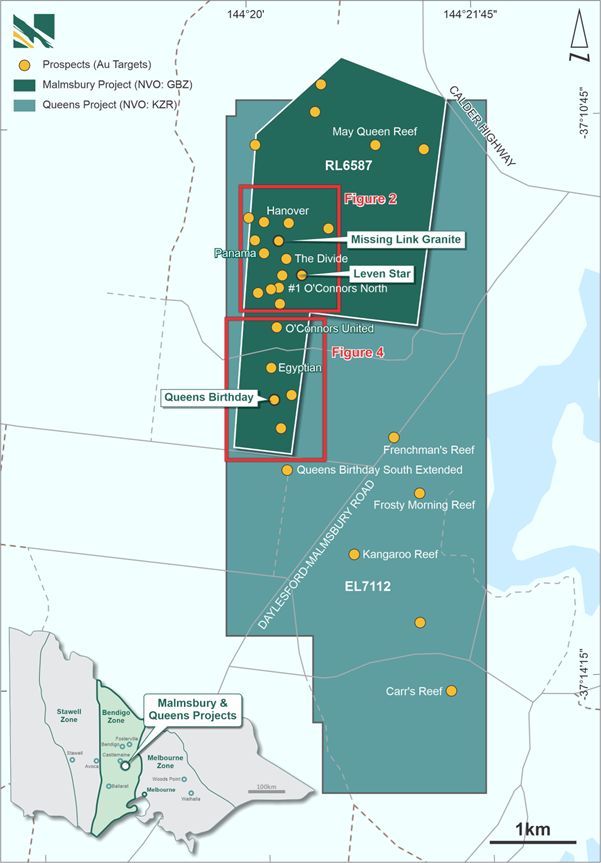
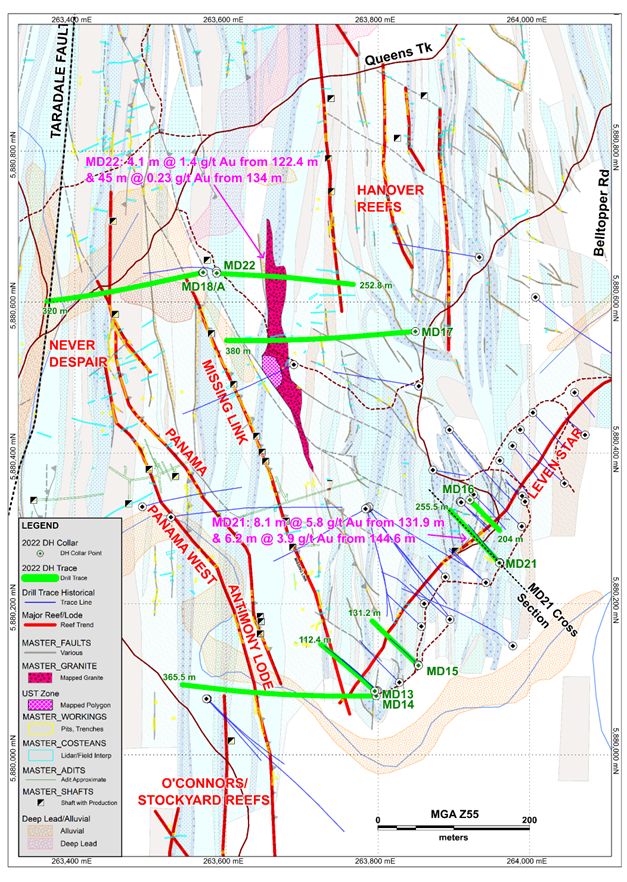
The Company has recently completed an 11-hole, 3,162 m diamond drill program at the Malmsbury Project, with positive results generated from several holes reported previously (see Novo press release), and now including high-grade assays from the Queens Birthday and Leven Star reefs. Key results generated from drilling include:
- 3.1 m @ 9.27 g/t Au from 400.9 m (MD20)
- 8.1 m @ 5.79 g/t Au from 131.9 m (MD21);
- 6.2 m @ 3.92 g/t Au from 144.6 m (MD21); and
- Step-out hole (MD22) intersected 45 m @ 0.23 g/t Au from 134 m, 80 m north of previous reported drilling (MD17)
Novo exercised its option over the Malmsbury Project to earn a 50% interest, and the right to earn an additional 10% interest by incurring A$5 million in exploration expenditure over a four-year period2.
Novo exercised its option over the Queens Project to earn a 50% interest, and the right to earn an additional 20% interest by incurring A$5 million in exploration expenditure over a five-year period3.
Results referred to in this news release are not necessarily representative of mineralization throughout the Malmsbury Project and the Queens Project.
DETAILS
Drilling Program Update
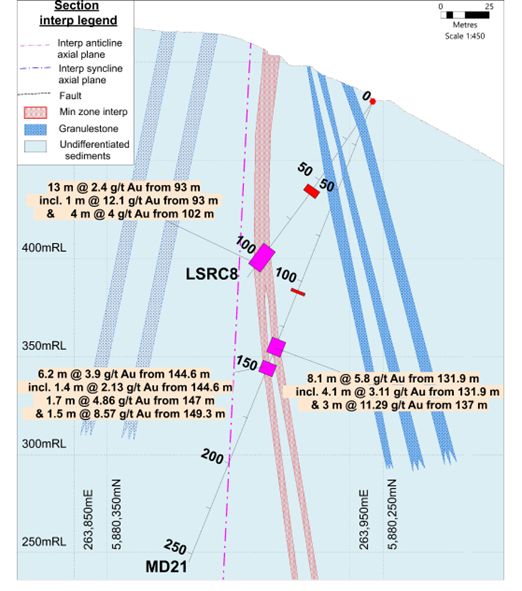
All gold and multi-element assays have now been returned from the 11-hole, 3,162 m diamond drilling program at the Malmsbury Project. Significant results from the final three holes (MD20, MD21 and MD22) are presented herein. Significant results for earlier holes (MD13 through MD19) have been reported previously.4,1,5
Table 1 below highlights new >1 gram metre results reported for drill holes MD20, MD21 and MD22 testing reef-related mineralization. Intersections presented for MD20 are considered at or near true width. An oblique component to the intersections in both MD21 and MD22 is interpreted. True width intersections will reduce for MD21 and MD22 when mineralization is interpreted and modelled.
Table 1: Significant intercept table for results from drill holes MD20 and MD21 and MD22. The table is generated using a 0.3 g/t Au cut-off grade and no more than 2 m internal waste. Higher grade “Includes,” intercepts calculated with 1 g/t Au cut-off grade and no internal dilution. All intervals > 1 gram metre Au reported here.
| HOLE ID | COORDSYS | Collar Details | AZI
GRID |
DIP |
Includes |
DEPTH
FROM |
DEPTH
TO |
Au
(ppm) |
Width
(m) |
Gram*
metre |
||
| EASTING | NORTHING | RL | ||||||||||
| MD20 | MGA94_55 | 263828 | 5878871 | 477 | 260 | -58 | 244.8 | 245.8 | 1.13 | 1 | 1.13 | |
| MD20 | MGA94_55 | 263828 | 5878871 | 477 | 260 | -58 | 400.9*1 | 404 | 9.27 | 3.1*1 | 28.74*1 | |
| MD20 | MGA94_55 | 263828 | 5878871 | 477 | 260 | -58 | Inc. | 400.9*1 | 403.24 | 12.0 | 2.34 | 28.11*1 |
| MD21 | MGA94_55 | 263959 | 5880254 | 481 | 318.6 | -68.4 | 105 | 106.5 | 2.53 | 1.5 | 3.79 | |
| MD21 | MGA94_55 | 263959 | 5880254 | 481 | 318.6 | -68.4 | 131.9 | 140 | 5.79 | 8.1 | 46.90 | |
| MD21 | MGA94_55 | 263959 | 5880254 | 481 | 318.6 | -68.4 | Inc. | 131.9 | 136 | 3.11 | 4.1 | 12.74 |
| MD21 | MGA94_55 | 263959 | 5880254 | 481 | 318.6 | -68.4 | Inc. | 137 | 140 | 11.29 | 3 | 33.86 |
| MD21 | MGA94_55 | 263959 | 5880254 | 481 | 318.6 | -68.4 | 144.6 | 150.8 | 3.92 | 6.2 | 24.33 | |
| MD21 | MGA94_55 | 263959 | 5880254 | 481 | 318.6 | -68.4 | Inc. | 144.6 | 146 | 2.13 | 1.4 | 2.98 |
| MD21 | MGA94_55 | 263959 | 5880254 | 481 | 318.6 | -68.4 | Inc. | 147 | 148.7 | 4.86 | 1.7 | 8.25 |
| MD21 | MGA94_55 | 263959 | 5880254 | 481 | 318.6 | -68.4 | Inc | 149.3 | 150.8 | 8.57 | 1.5 | 12.86 |
| MD22 | MGA94_55 | 263587 | 5880638 | 471 | 93.9 | -45.9 | 7 | 9 | 0.59 | 2 | 1.17 | |
| MD22 | MGA94_55 | 263587 | 5880638 | 471 | 93.9 | -45.9 | 87.6 | 88.8 | 3.81 | 1.2 | 4.57 | |
| MD22 | MGA94_55 | 263587 | 5880638 | 471 | 93.9 | -45.9 | 122.4 | 126.5 | 1.38 | 4.1 | 5.65 | |
*1 Intersection in MD20 remains open. No sampling immediately prior to mineralised interval from 400.9 m.
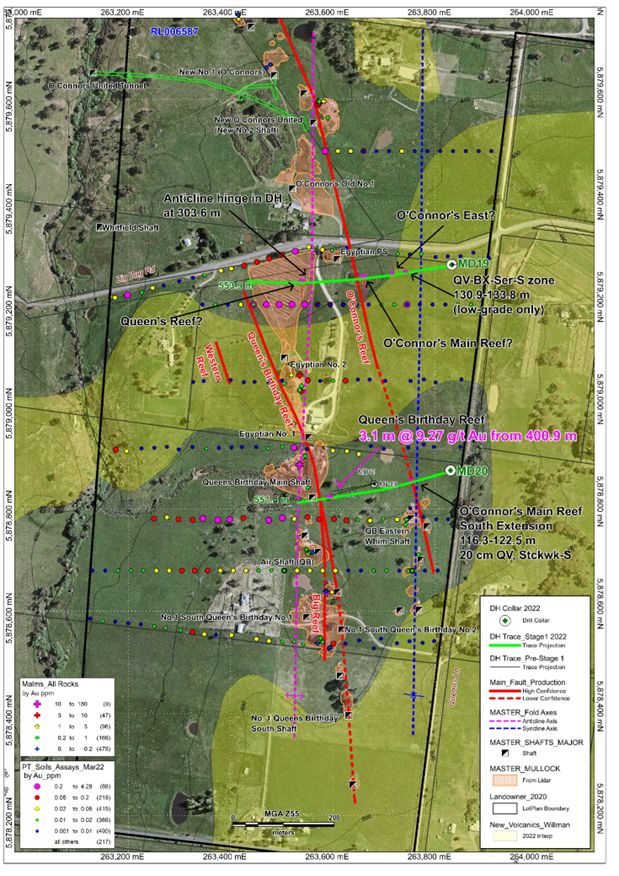
Table 2 below highlights new >1 gram metre results reported for a significant intersection in MD22 across the mineralised felsic intrusive (Missing Link Monzogranite) representing intrusion related gold (“IRG”) mineralization and/or intrusion-hosted mineralization. An oblique component to the intersection presented for MD22 is interpreted. Different parameters to calculate the intersections are used for reef-related verses IRG or intrusion hosted mineralization. These parameters are outlined clearly in the respective tables.
Table 2: Significant intercept table for result across mineralised felsic intrusive (Missing Link Monzogranite) in drill holes MD22. The table is generated using a 0.1 g/t Au cut-off grade and no more than 5 m internal waste. All intervals > 1 gram metre Au reported here.
| HOLE ID | COORDSYS | Collar Details | AZI
GRID |
DIP |
Includes |
DEPTH
FROM |
DEPTH
TO |
Au
(ppm) |
Width
(m) |
Gram*
metre |
||
| EASTING | NORTHING | RL | ||||||||||
| MD22 | MGA94_55 | 263587 | 5880638 | 471 | 93.9 | -45.9 | 134 | 179 | 0.23 | 45 | 10.41 | |
The above references an opinion and is for information purposes only. It is not intended to be investment advice. Seek a licensed professional for investment advice. The author is not an insider or shareholder of any of the companies mentioned above.
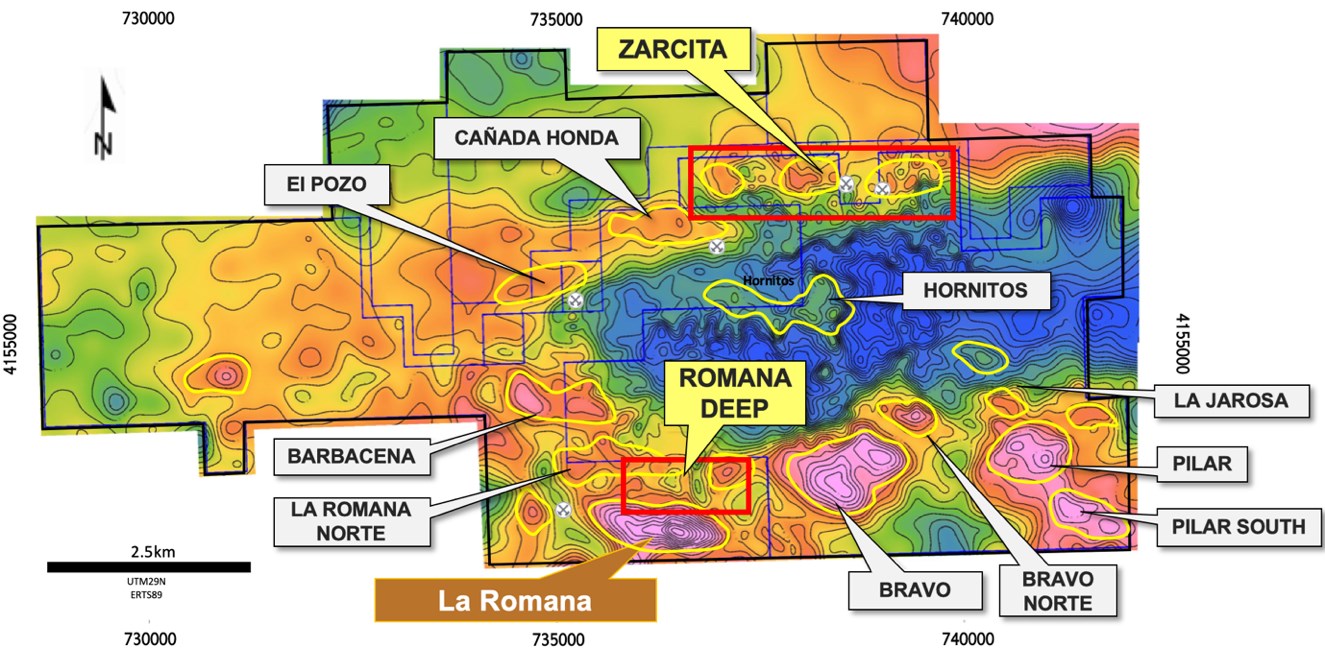
Pan Global Resources (TSXV:PGZ) has announced that drilling has begun at the Romana Deep volcanogenic massive sulphide targets at the 100%-owned Escacena Project. Located in Spain, the initial program at the project consists of four widely spaced drill holes and is aimed at providing the first test for the Romana Deep target.
Tim Moody, Pan Global President and CEO, commented in a press release: “Romana Deep is a compelling target featuring a large HEM anomaly extending down-dip from Pan Global’s La Romana copper discovery. Some of the strongest copper mineralization at La Romana exhibits a similar HEM signature and the copper mineralization remains open in the direction of the Romana Deep target. The first of four planned drill holes has commenced at Romana Deep. In addition, drilling continues to the north at the high priority Zarcita target.”
Romana Deep Target
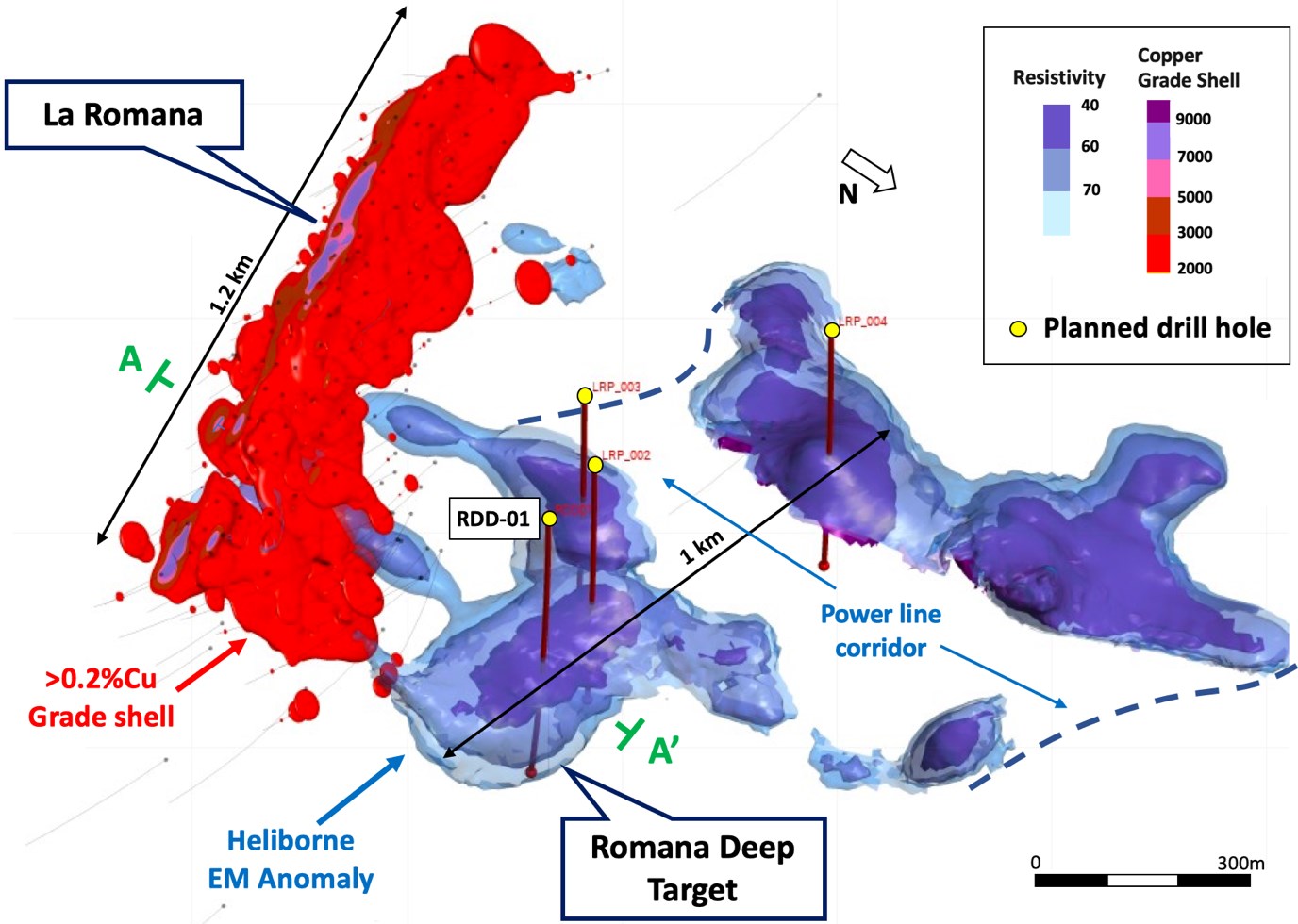
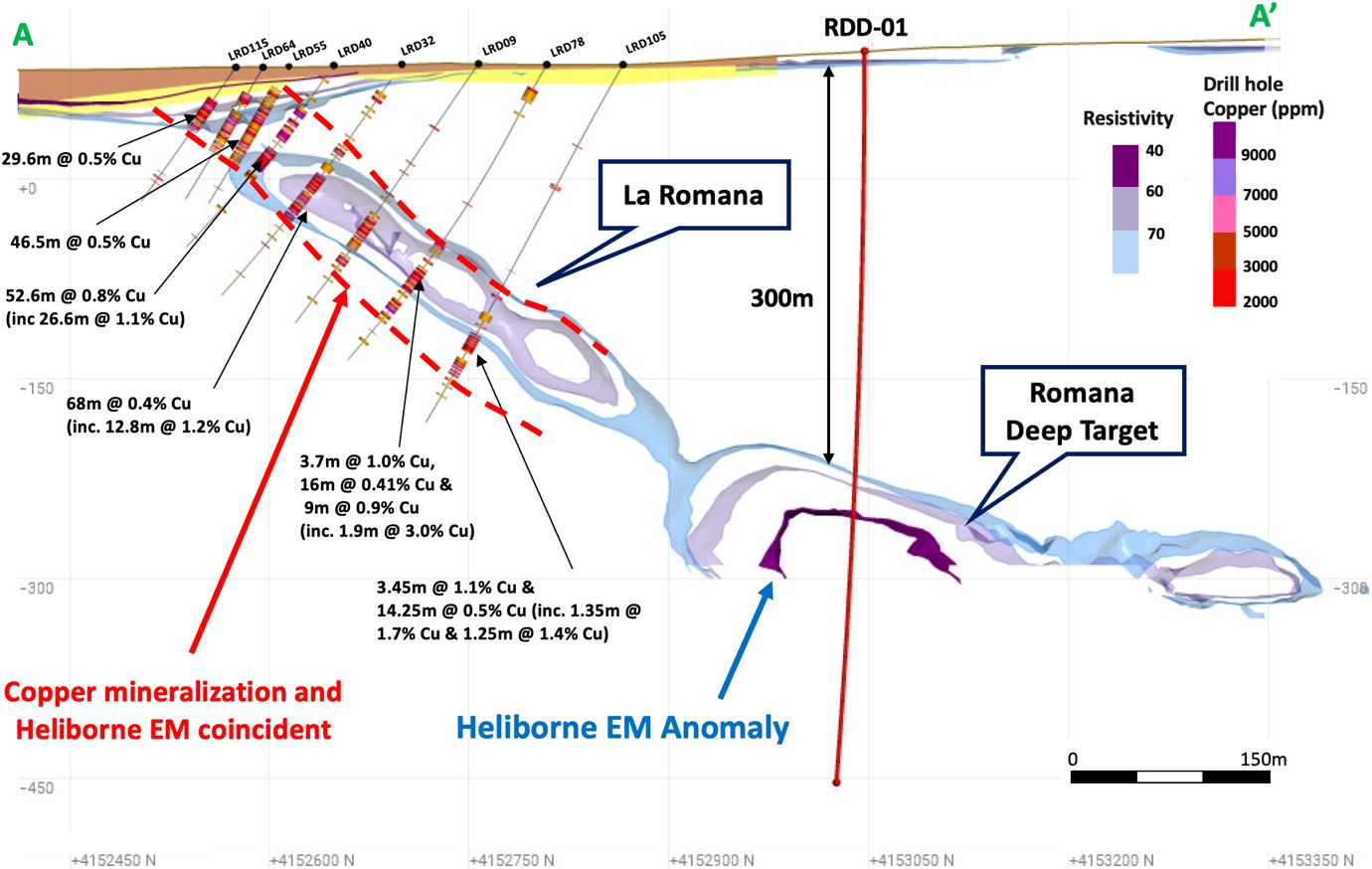
Further processing and interpretation of the Company’s recently completed HEM survey has significantly expanded the previously identified Romana Deep target (see previous news release on September 28, 2022). The Romana Deep target is characterized by a large HEM resistivity low anomaly located down-dip from Pan Global’s near-surface La Romana copper discovery (see Figure 1 above). The target is also less than 5 kilometres southwest of the former producing Aznalcollar open pit copper-zinc mine.
The copper-tin mineralization at La Romana also coincides with HEM resistivity low anomalies, providing a further indicator of potential for additional copper mineralization associated with the Romana Deep HEM target. The target extends northwards from La Romana at a depth of approximately 300m and spans more than 1 km east-west. See Figures 2 and 3 below. An initial four drill holes, 150 to 350 meters apart, totalling approximately 2,000 meters are planned to test some of the strongest resistivity low anomalies within the broader target area.
About the Escacena Project
The Escacena Project comprises a large, contiguous, 5,760-hectare land package controlled 100% by Pan Global in the east of the Iberian Pyrite Belt. The project is located near operating mines at Las Cruces and Rio Tinto and is immediately adjacent to the former Aznalcollar and Los Frailes mines where Minera Los Frailes/Grupo Mexico is in the permitting stage to restart mining. The Escacena Project hosts the La Romana copper-tin discovery and a number of other prospective targets, including La Jarosa, Hornitos, Zarcita, Romana Deep, Pilar, Bravo and Barbacena.
The above references an opinion and is for information purposes only. It is not intended to be investment advice. Seek a licensed professional for investment advice. The author is not an insider or shareholder of any of the companies mentioned above.
Imperial Mining Group (TSXV:IPG) has announced that additional assays have been received from its Crater Lake drilling program on the TG scandium-rare earth mineralized zone. The results confirm the intersection widths of scandium-bearing olivine ferrosyenite that were previous reported. The program was completed in early September, and once all of the results are received from the lab and data compilation is completed, the company will undertake an updated 43-101 Resource Estimate for the zone. The goal of the new data is to convert the Inferred Category Resources from last year into Indicated/Measured Resources.
Peter Cashin, Imperial’s President & Chief Executive Officer commented in a press release: “The summer drilling results for the Crater Lake property continue to exceed all expectations, as they continue to confirm wide intervals of scandium and TREO+Y at the TGZ target. Drilling has now defined the Zone on 50 m sections between Sections 350N and 600N and mineralization has been traced by drilling over 600m in total strike length from surface to a vertical depth of 150 m (Figure 1). Importantly, the zone appears to get wider and higher grade with depth. We anticipate that the resource will likely increase from what was previously reported for the TG.”
Highlights from the results are as follows:
- Assay results from the three additional drillholes continue to return impressive grades of 98.6 (323.4’) grading 308 g/t scandium oxide (Sc2O3), including 52.8 m (173.2’) grading 322 g/t Sc2O3 and 113.7 m (372.9) grading 278 g/t Sc2O3, including 335 g/t Sc2O3 over 10.5 m (34.4’) and including 301 g/t over 16.75 m (54.9’).
- These are the deepest cuts (150 m vertical) into the TG Zone and confirm a thickening and grade increase to the mineralization at depth.
- Elevated levels of total rare earth oxides plus yttrium (TREO+Y) of up to 0.479% characterize the scandium-bearing horizon.
- At a gold price of $1,775US/oz and a scandium oxide price of $1,500US/kg, the intersections represent a gold-equivalent value of 7.3 to 8.8 g/t Au.
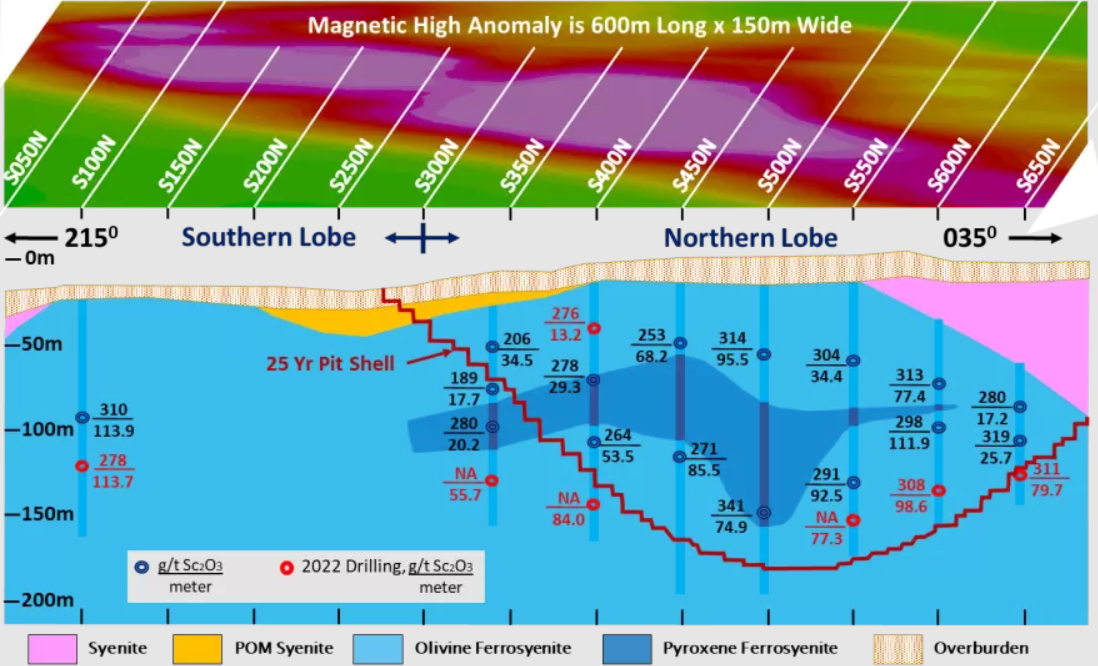
CURRENT DRILLING
To date, assays for three additional holes for 648.0 m have been received (Table 2, Figure 1). All drillholes have intersected the target mafic intrusive host rock. The drilling indicates that the TG scandium Zone is doubly dipping between 830 west to 700 east, with a north-northeast strike direction. The widths of the mineralized zone vary between 55 and 135 m (180-443’) in true thickness. Mineralization is open at depth below the 200 m vertical level and along strike and appears as a thickening, conical-shaped body in cross-section.
Table 1 – Crater Lake Drilling Best Assay Results:
| Hole # | From (m) | To (m) | Interval (m) | Sc (g/t) | Sc2O3 (g/t) | TREO+Y (%) |
| CL22056 | 34.00 | 47.20 | 13.2 | 180 | 276 | 0.383 |
| 73.95 | 79.0 | 5.05 | 179 | 275 | 0.230 | |
| CL22058 | 28.6 | 61.75 | 34.43 | 177 | 271 | 0.440 |
| Incl. | 46.6 | 61.75 | 15.15 | 201 | 308 | 0.473 |
| And | 107.0 | 157.5 | 50.5 | 191 | 293 | 0.353 |
| Incl. | 107.0 | 127.0 | 20.0 | 196 | 301 | 0.359 |
| and Incl. | 131.0 | 157.5 | 26.5 | 206 | 317 | 0.382 |
| CL22059 | 85.8 | 201.3 | 115.5 | 177 | 271 | 0.320 |
| Incl. | 85.8 | 98.54 | 12.74 | 211 | 323 | 0.457 |
| and Incl. | 111.35 | 164.15 | 52.8 | 210 | 321 | 0.372 |
| and Incl. | 168.25 | 201.3 | 33.05 | 183 | 281 | 0.307 |
NOTES: – 1 ppm of Sc metal equals 1.5338 ppm scandium oxide (Sc2O3) ; 1 g/t equals 1 ppm. TREO+Y includes oxides of La, Ce, Pr, Nd, Sm, Eu, Gd, Tb, Dy, Ho, Er, Tm, Yb and Lu plus Y.
Table 2 – Borehole Location Table – Crater Lake Project, Quebec
| Borehole | Section | Easting | Northing | Elevation | Azimuth | Dip | Length (m) | |
| CL22056 | 400N | 440730 | 6133700 | 551 | 305 | -45 | 147.0 | |
| CL22058 | 100N | 440685 | 6133363 | 533 | 305 | -50 | 234.0 | |
| CL22059 | 600N | 440992 | 6133751 | 542 | 305 | -49 | 267.0 | |
| CL22060 | 550N | 440967 | 6133713 | 541 | 305 | -50 | 267.0 | |
| CL22061 | 400N | 440815 | 6133629 | 541 | 305 | -48 | 240.0 | |
| CL22062 | 350N | 440780 | 6133586 | 541 | 305 | -52 | 231.0 | |
The above references an opinion and is for information purposes only. It is not intended to be investment advice. Seek a licensed professional for investment advice. The author is not an insider or shareholder of any of the companies mentioned above.
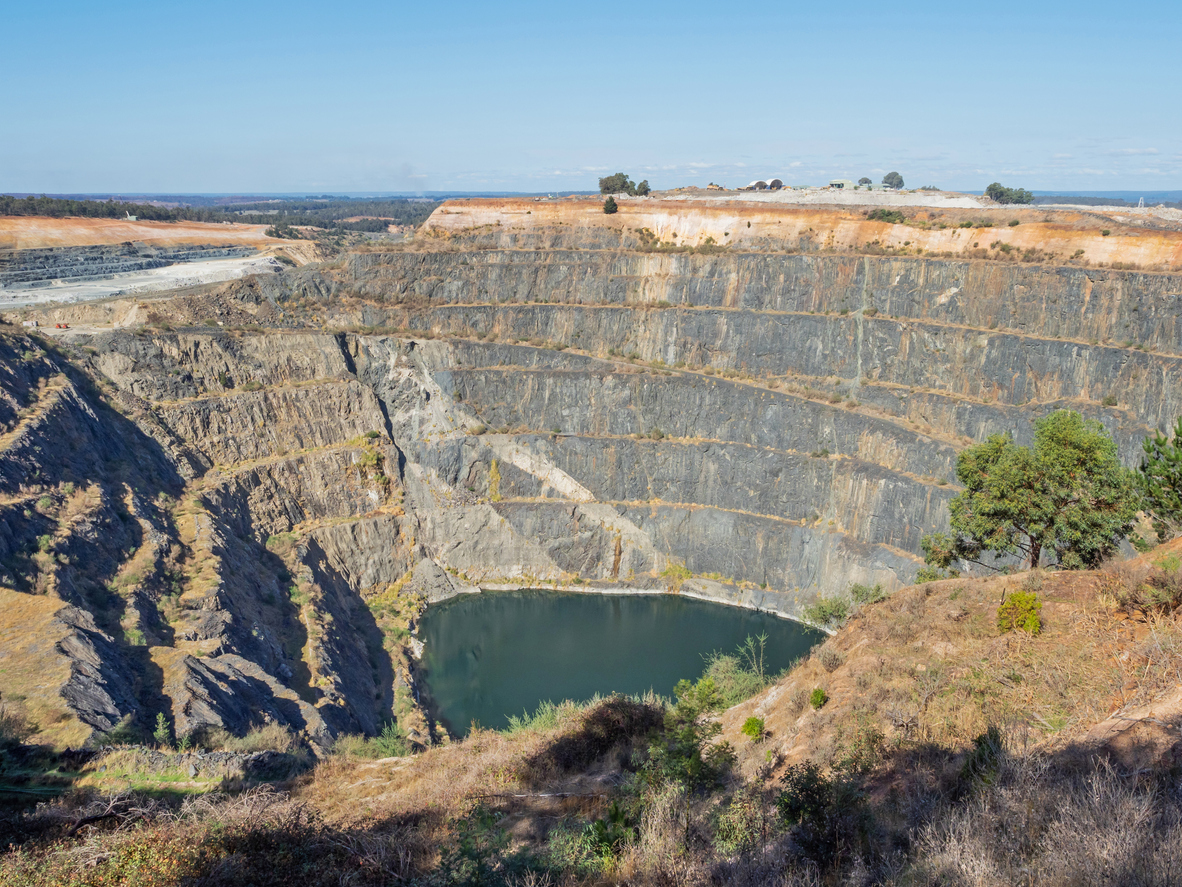
Australian lithium-focused miner Pilbara Minerals (ASX:PLS) has announced it will begin paying dividends to shareholders. The company made the announcement as it continues to benefit from favourable market conditions for lithium. It is targeting a payout ratio of 20%-30% of free cash flow, and will apply the dividend to the current 2023 financial year. As of September 30, the company has a cash balance of A$1.375 billion ($929 million), a strong position for Pilbara, allowing it to implement the dividend for the first time since its inception 15 years ago.
The dynamics in the lithium market are pushing prices higher for a few important reasons. Lithium is notoriously difficult to mine, with high costs and a low production rate. This means that the market is currently dominated by a small number of producers. A small number of companies are reportedly responsible for the vast majority of production, allowing them to control output. Many of the largest lithium deposits are 100%-owned by a handful of companies, making it difficult for the industry to begin new exploration.
The market for lithium is also growing rapidly, with an estimated compound annual growth rate of 9% over the next five years. This is due to a number of factors, including the development of green energy and the increasing demand for batteries for electronic devices.
Technology is changing rapidly, and new applications of lithium are being developed all the time. This is likely to drive the demand for lithium even further in the future. Lithium is used in many important products, such as smartphones, laptops, and electric vehicles, and it is important that the supply is able to meet the demand.
As the electrification of the global economy continues, more lithium will be needed for the lithium-ion batteries used in these devices. This is good news for investors in companies like Pilbara Minerals, as it means that the demand for the mineral is likely to remain high for decades.
Spodumene, used in the manufacturing of high-purity lithium-ion batteries for electric vehicles and electronics, is the key material for the future of the lithium industry.
Pilbara Minerals reported production of 377,902 dry metric tonnes (dmt) of spodumene concentrate in fiscal 2022. That market a 34% production boost over 2021, and the company forecasted between 540-580,000 dmt of production in fiscal 2023.
Companies are also trying to speed up their plans for mining lithium to reduce dependency on China for EV battery raw materials. The fragility of the supply chain and the potential for geopolitical disruptions means that there is significant risk in investing in lithium production, but rising prices continue to motivate lithium miners to invest in new exploration and projects.
Despite these risks, there are a number of companies that are still willing to invest in the lithium industry. Pilbara Minerals is one of these companies, and its announcement that it will begin paying dividends is a positive sign.
The above references an opinion and is for information purposes only. It is not intended to be investment advice. Seek a licensed professional for investment advice. The author is not an insider or shareholder of any of the companies mentioned above.
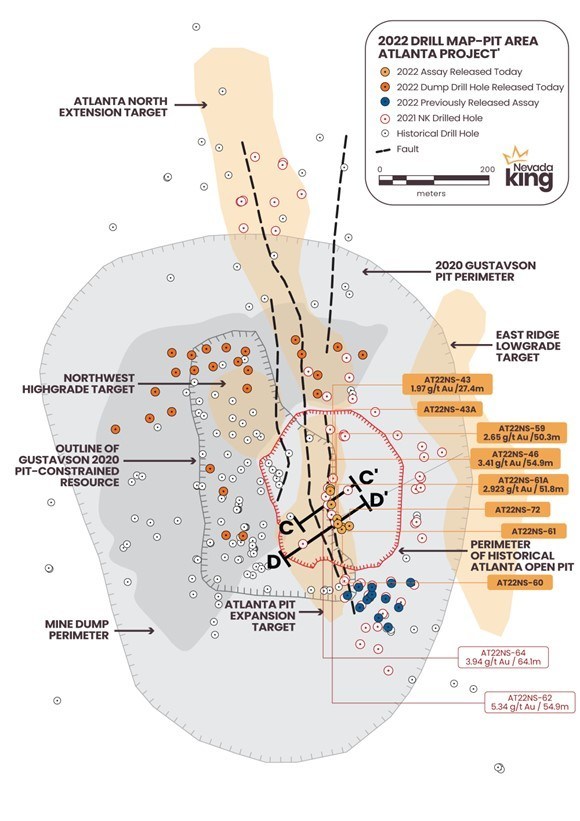
Nevada King Gold (TSXV:NKG) has announced that its Phase II resource expansion and definition drilling program at the 5,166-hectare Atlanta Gold Mine project will be increased. The project is located in the Battle Mountain Trend 264km northeast of Las Vegas, Nevada, and is 100%-owned by Nevada King Gold.
The company is the third largest mineral claim holder in the state, just behind Nevada Gold Mines (Barrick/Newmont) and Kinross. In 2016, the company began staking large project areas hosting significant historical exploration work along the Battle Mountain trend located close to current or former producing gold mines.
Initially, these areas were selected for their potential for hosting multi-million-ounce gold deposits and were then staked after a detailed geological evaluation. Projects in the company’s portfolio include the Atlanta Mine, the Lewis and Horse Mountain-Mill Creek projects, and the Iron point project. Nevada King Gold continues to be well funded with approximately $14.5 million in cash as of November 2022.
Exploration Manager Cal Herron, P.Geo., commented in a press release: “Since our last update two weeks ago, the drills have advanced down the west pit wall stepping closer to the high-grade zone hit in last year’s drilling along the pit floor. Expanding the program and running it into the winter months will allow us to maintain our current momentum targeting further definition and expansion of the high-grade gold mineralization targets defined so far which remain open in all directions, as well as to test target areas not drilled to date. We are continually surprised by the complicated faulting and rapidly changing alteration patterns revealed with each step-out exploration hole. When examined in detail, the Atlanta gold system is proving to be very complex and difficult to decipher, which in itself is a hallmark of many large deposits. We anticipate a flurry of assays to start arriving shortly, which will allow us to update our modelling and continue to fine tune the targeting in on-going drilling program leading to an updated resource estimate.”
Highlights from the update are as follows:
- On November 1, 2022, the Company announced a 20% expansion to its Atlanta Mine Phase II drill program, from the originally planned 13,100m (100 holes) to 16,000m of combined core and reverse-circulation (“RC“) drilling.
- Drilling productivity has exceeded expectations with the Company having now completed 16,450m (138 holes).
- Based on assay results received to date, drill hole logging and ongoing geological interpretation based on this work, target areas at Atlanta continue to grow and the Company has decided to again expand the Phase II program another 25% to 20,000m, and to extend the program into the winter months.
- A track-mounted RC drill capable of accessing and drilling in harder to reach areas is being added to the program, with this rig scheduled to arrive on site within the next two weeks. Utilizing equipment already on-site, including the recent addition of water tank heaters, infrastructure is now in place to keep the drill program running into the winter months, with at least two rigs active.
- To date, the Company has reported assays from 2,455m of drilling, while assay results from 13,995m of drilling are currently pending.
Phase II Drilling Highlights are as follows:
- The Company reported initial assay results on September 13, 2022 and October 18, 2022. The results included high-grade oxide-hosted intervals of 120.4m of 1.49 g/t Au and 57.9m of 1.38 g/t Au, located south and southeast of the Atlanta pit, and 54.9m of 3.41 g/t Au, 50.3m of 2.65 g/t Au, and 51.8m of 2.23 g/t Au, starting from surface at the bottom of the Atlanta pit.
- Drilling continues to target high-grade gold mineralization along the Atlanta Mine Fault Zone (“AMFZ“), westward and southwestward from last year’s drilling. Assays from these target areas returned high-grade intercepts including 41.2m of 3.94 g/t Au, 64m of 3.35 g/t Au, and 54.9m of 5.34 g/t Au, also starting at surface from within the Atlanta pit (see January 20, 2022, news release).
The above references an opinion and is for information purposes only. It is not intended to be investment advice. Seek a licensed professional for investment advice. The author is not an insider or shareholder of any of the companies mentioned above.
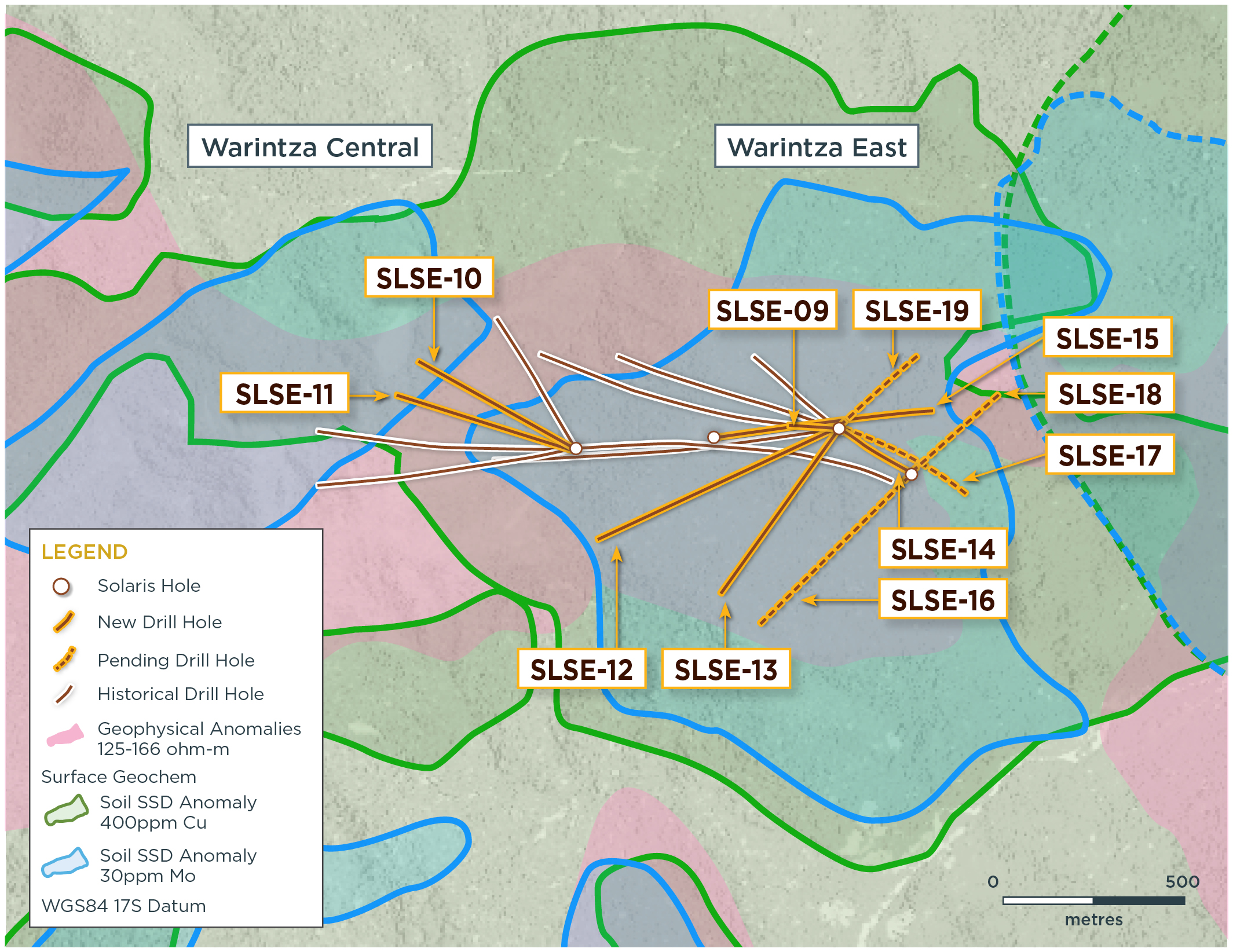
Solaris Resources (TSX:SLS) (OTCQB:SLSSF) has reported assay results from a series of holes aimed at delineating resources at the Warintza East discovery at the Warintza Project. These results significantly expand the Warintza East discovery originally discovered in July 2021, and included eight holes covering the overlapping periphery included in the Warintza Central Mineral Resource Estimate from April 2022. The results expand the dimensions of the Warintza East footprint to the east and southwest, and the deposit remains open towards strong soil anomalism to the northeast and southeast.
Mr. Jorge Fierro, Vice President, Exploration, commented in a press release: “Drilling to date covers only a small portion of the Warintza East discovery, which represents a target for major resource growth. Further extensional and step-out drilling is planned to the east and southeast with a 400m step-out platform located on the southern margin of the drill grid targeting strong soil anomalism in this area.”
Highlights from the results include:
- SLSE-15 was collared in the middle of the Warintza East grid and drilled east into a partially open volume, returning 204m of 0.60% CuEq² within a broader interval of 910m of 0.40% CuEq² from near surface, extending mineralization to the east where it remains open
- SLSE-14, stepped out approximately 250m from the eastern limit of the grid and drilled northwest into an open volume, returning 292m of 0.50% CuEq² within a broader interval of 694m of 0.40% CuEq² from near surface, extending mineralization in this direction where it remains open
- SLSE-12 was collared at the eastern limit of the grid and drilled southwest into an open volume, returning 48m of 0.53% CuEq² within a broader interval of 508m of 0.40% CuEq² from surface, extending mineralization in this direction
- SLSE-13 was collared from the same platform and drilled southwest into an open volume, returning 104m of 0.45% CuEq² within a broader interval of 618m of 0.29% CuEq² from surface, expanding the footprint to the south where it remains open
- SLSE-10 and SLSE-11 were collared in the overlapping portion with Warintza Central and drilled northwest into partially open volumes, returning 282m of 0.53% CuEq² and 270m of 0.55% CuEq², respectively, within broader intervals from near surface
- Drilling to date confirms Warintza East as a significant porphyry deposit which remains open for expansion in multiple areas, with assays pending from a series of extensional holes to the northeast, east and south
Figure 1 – Plan View of Warintza East Drilling Released to Date
Table 1 – Assay Results
| Hole ID | Date Reported | From (m) | To (m) | Interval (m) | Cu (%) | Mo (%) | Au (g/t) | CuEq² (%) |
| SLSE-15 | Nov 14, 2022 | 124 | 1,034 | 910 | 0.31 | 0.02 | 0.04 | 0.40 |
| Including | 252 | 456 | 204 | 0.50 | 0.02 | 0.05 | 0.60 | |
| SLSE-14 | 24 | 718 | 694 | 0.29 | 0.02 | 0.04 | 0.40 | |
| Including | 24 | 316 | 292 | 0.40 | 0.02 | 0.05 | 0.50 | |
| SLSE-13 | 4 | 622 | 618 | 0.22 | 0.01 | 0.03 | 0.29 | |
| Including | 0 | 104 | 104 | 0.31 | 0.03 | 0.03 | 0.45 | |
| SLSE-12 | 0 | 508 | 508 | 0.29 | 0.02 | 0.04 | 0.40 | |
| Including | 0 | 48 | 48 | 0.46 | 0.01 | 0.04 | 0.53 | |
| SLSE-11 | 112 | 600 | 488 | 0.30 | 0.01 | 0.03 | 0.38 | |
| Including | 330 | 600 | 270 | 0.43 | 0.03 | 0.04 | 0.55 | |
| SLSE-10 | 78 | 576 | 498 | 0.33 | 0.01 | 0.05 | 0.39 | |
| Including | 294 | 576 | 282 | 0.44 | 0.01 | 0.06 | 0.53 | |
| SLSE-09 | 0 | 773 | 773 | 0.18 | 0.03 | 0.03 | 0.30 | |
| Including | 0 | 212 | 212 | 0.30 | 0.02 | 0.04 | 0.42 |
Notes to table: True widths of the mineralized zone are not known at this time.
Table 2 – Collar Location
| Hole ID | Easting | Northing | Elevation (m) | Depth (m) | Azimuth (degrees) | Dip (degrees) |
| SLSE-15 | 801134 | 9648177 | 1382 | 1070 | 85 | -62 |
| SLSE-14 | 801684 | 9648074 | 1221 | 872 | 300 | -75 |
| SLSE-13 | 801481 | 9648205 | 1170 | 800 | 215 | -45 |
| SLSE-12 | 801485 | 9648192 | 1170 | 981 | 245 | -46 |
| SLSE-11 | 800749 | 9648146 | 1282 | 862 | 285 | -60 |
| SLSE-10 | 800749 | 9648146 | 1282 | 691 | 300 | -50 |
| SLSE-09 | 801485 | 9648192 | 1170 | 774 | 271 | -80 |
| Notes to table: The coordinates are in WGS84 17S Datum. |
Endnotes
- Refer to Solaris’ press release dated April 18, 2022 and technical report titled, “NI 43-101 Technical Report for the Warintza Project, Ecuador” with an effective date of April 1, 2022, prepared by Mario E. Rossi and filed on the Company’s SEDAR profile at www.sedar.com.
- Copper-equivalence calculated as: CuEq (%) = Cu (%) + 4.0476 × Mo (%) + 0.487 × Au (g/t), utilizing metal prices of US$3.50/lb Cu, US$15.00/lb Mo, and US$1,500/oz Au, and assumes recoveries of 90% Cu, 85% Mo, and 70% Au based on preliminary metallurgical test work.
The above references an opinion and is for information purposes only. It is not intended to be investment advice. Seek a licensed professional for investment advice. The author is not an insider or shareholder of any of the companies mentioned above.
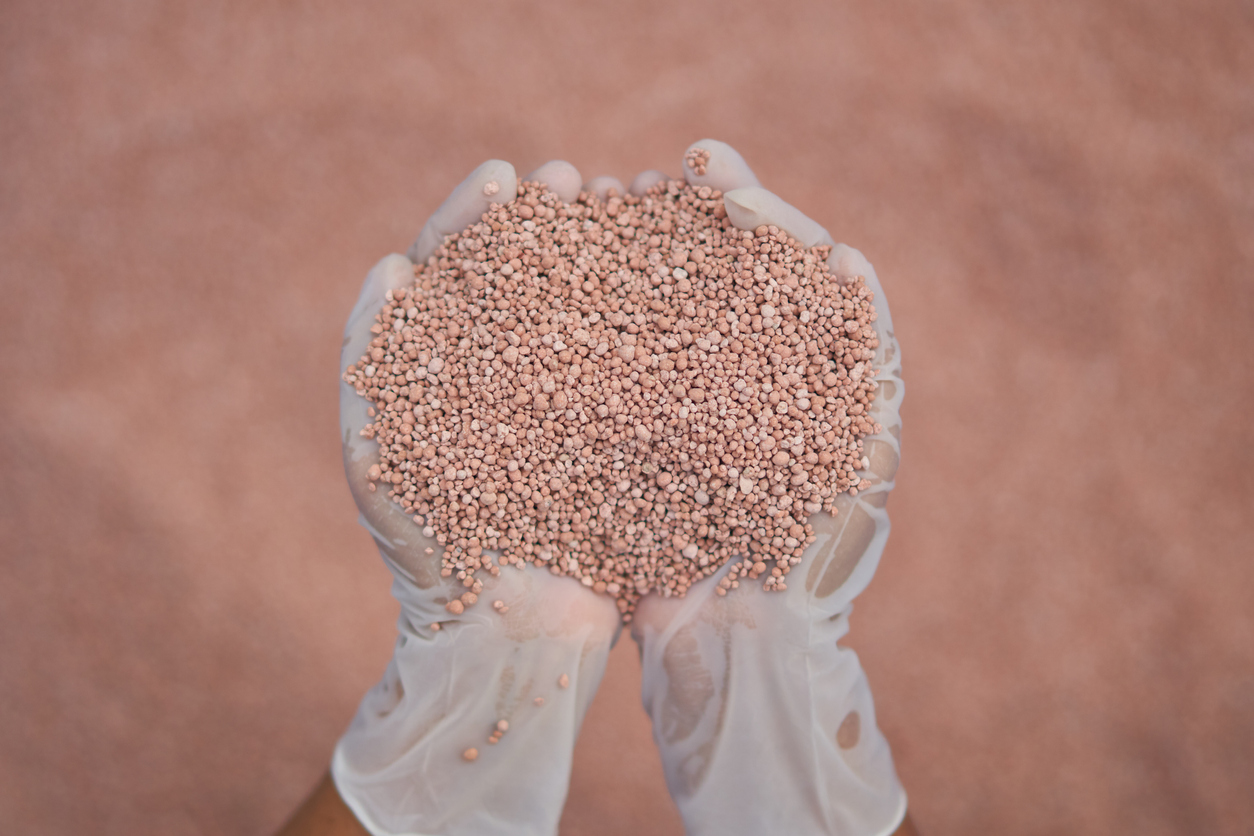
The world has changed dramatically in the last few decades, with the rise of alternative energy sources such as solar and wind. The potash mining industry is also beginning to shift its focus, looking for cleaner and more environmentally-friendly methods of extracting the valuable mineral.
Potash is used in several industrial applications, such as fertilizer, plastics and ceramics. The mining process of potash uses a great deal of water and energy, and it has been linked to environmental damage, including water contamination and air pollution.
One project that is looking to address these concerns is the Autazes Potash Project in Brazil from Brazil Potash. The goal of the project is to develop a more environmentally-friendly method of extracting potash from the ground while doubling current production and changing the domestic potash market dynamic in Brazil.
One of the main advantages of the Autazes Potash Project is that it uses a more sustainable method of extracting potash from the ground. The project will employ a process for extracting Sylvinite, a rock made up of halite (salt) and Sylvite, or Sylvine (potassium chloride), which will not harm the earth’s surface soil or environment. The chambers and pillars technique will be utilized throughout the entire extraction operation.
This method is much more environmentally-friendly than traditional methods of extracting potash, which uses a great deal of water and energy. It also does not damage the environment or the local water supply to the extent of traditional mining, which is a major concern with other methods of extracting potash by solution mining.
The potash market is facing challenges due to the entrenched nature of the producing countries and the largest importers of the mineral. The Autazes Potash Project is looking to address these challenges by bringing a new project to the market to fill Brazil’s massive demand for potash.
Brazil’s agricultural industry is one of the country’s largest employers, and the potash industry is a major contributor to the country’s economy. However, right now, Brazil is a net importer. This raises costs for the industry and creates risks to supply chains. The current disruptions in the market due to issues with Russian and Belarusian exports have highlighted the urgent need for a project like Autazes to be permitted as soon as possible.
The Brazilian government has given the project its support, and this year there has been plenty of discussion of the importance of fertilizers to the country. The administration released the National Fertilizer Plan, highlighting the importance of potash in the country’s fertilizer mix.
Brazil Potash’s management team is another reason that this project is such an important one. The team has a strong track record of developing and bringing projects into production. In addition, the company’s board of directors includes advice from representatives from some of the world’s largest agribusiness companies, which provides valuable insights into the industry.
The Autazes Project is a major step forward in the quest to find more environmentally-friendly methods of extracting potash. The project has the potential to revolutionize the way the potash market works, and it has the backing of the Brazilian government. If the project is successful, it could lead to a more environmentally-friendly way of extracting potash, and ultimately, a cleaner and healthier environment while balancing the Brazilian domestic potash market.
The above references an opinion and is for information purposes only. It is not intended to be investment advice. Seek a licensed professional for investment advice. The author is not an insider or shareholder of any of the companies mentioned above.
Metal Energy Corp. (TSXV:MERG) has provided an update on its high-grade nickel and copper-cobalt Manibridge project in the Thompson Nickel Belt, Manitoba. Currently, drilling is focused in the shadow of the past-producing mine that from 1971 to 1977 produce 1.3 million tonnes at 2.55% nickel and 0.27% copper.
The Manibridge project is 4,368 hectares within the world-class Thompson Nickel Belt. Located approximately 20 kilometres southwest Wabowden, the location grants it infrastructure and capacity that has supported other drill programs. Metal Energy is a nickel and battery metal exploration company. The company is well-funded, and currently has two main projects, Manibridge and Strange, located in the stable mining jurisdictions of Manitoba and Ontario, Canada, respectively. The company has earn-in agreements at both properties allowing it to acquire 100% exploration rights to approximately 16,200 hectares.
James Sykes, CEO of Metal Energy, commented in a press release: “We completed a total of 5,331 m in nineteen drill holes (MNB007 to MNB025) between June 6 and July 28. Sixteen drill holes intersected the bedrock, each intersecting nickel-copper-cobalt sulphide mineralization over significant widths. These visual observations were confirmed with a handheld XRF*. Combined with the six drill holes from the winter program, we have a 100% nickel sulphide intersection success rate in all of our completed drill holes at Manibridge. We’ve drilled wide- and tight-spaced drill holes across a kilometre strike length and as deep as 700 m; every drill hole continues to intersect Ni-Cu-Co sulphides. Our recent Option Agreements with Mistango River Resource Inc. provides us with a unique opportunity to continue the Program with minimal dilution, greater insider ownership aligning with shareholders, and preserving capital. We are excited to renew our Phase 2 drill program, and complete the remaining 4,669 m as we progress southwest along this fertile corridor towards the old mine workings.”
Highlights from the update are as follows:
Manibridge Phase 2 Drill Program Summary
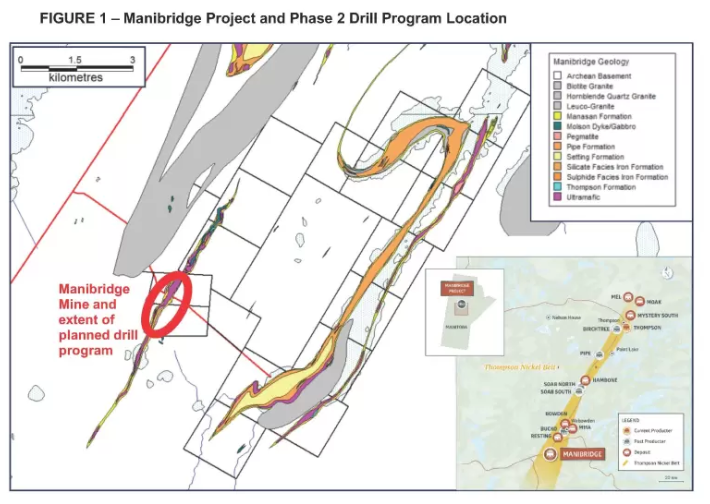
The Program is planned for 10,000 metres of diamond drilling in approximately 33 drill holes. A total of 5,331 m were completed in 19 drill holes (MNB007 to MNB025) between June 6 and July 28 (Table 1). The drill hole collar locations were within 300 to 600 metres of the old mine workings. The remaining drill holes will progress between 150 to 300 metres of the old mine workings. The average drill hole depths remain planned for between 225 and 400 metres. All drill holes will be inclined between -45 and -85. Figure 1 is a location map of the drill program within the Manibridge project. Figure 2 shows the drill hole locations with respect to the historic Manibridge Mine.
All sixteen drill holes that successfully intersected the bedrock also intersected Ni-Cu-Co sulphide mineralization, confirmed with a handheld XRF*. Drill core observations and XRF results confirm sulphide-rich lithostratigraphy ranges from 1 m thick (MNB018) to 55 m thick (MNB021), with an average thickness exceeding 15 m. Fourteen drill holes intersected two or more zones of Ni-Cu-Co sulphides. All drill holes had evidence of Ni-Cu-Co sulphides occurring as either disseminations within the mafic to ultramafic host rocks, remobilized in foliations and shears, vein-hosted, and/or net-textured or brecciated.
Geochemical assays will be released as they become available from the lab and reviewed for QA/QC by the Company’s Technical team.
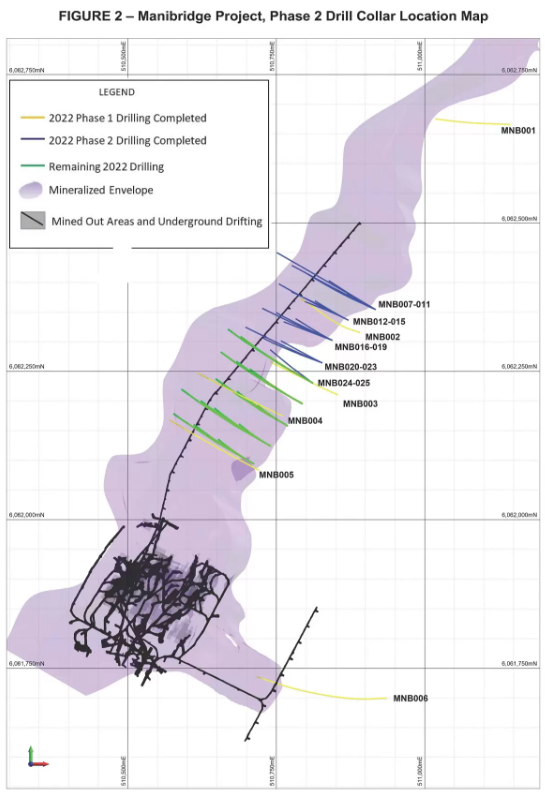
Metal Energy is the operator of the Program, holds 70% of the Project, and is currently earning towards 100% ownership of Manibridge, which is expected to be earned by the end of 2022. CanAlaska Uranium Ltd. currently holds the remaining 30% of the Project.
| *Handheld XRF (“hXRF”) results do not replace traditional laboratory-based analysis, however the results do provide an effective screening tool for the determination of nickel-copper-cobalt sulphides for selecting samples for geochemical assay analysis. hXRF analyses were taken on every 10 cm to 50 cm of the surface of the core as spot analyses with a 1 cm view window wherever visible sulphides and/or ultramafic rock types were present. The hXRF model used was a Niton XL5 and operated by Metal Energy Corp. The reader is cautioned that these width results might not reflect laboratory-quality width results and therefore should only be viewed as an initial screening for the presence of nickel-copper-cobalt sulphides within the drill core.
Table 1 – Selected Historic and Recent Drill Intersections on Manibridge
Notes to Table 1:
|
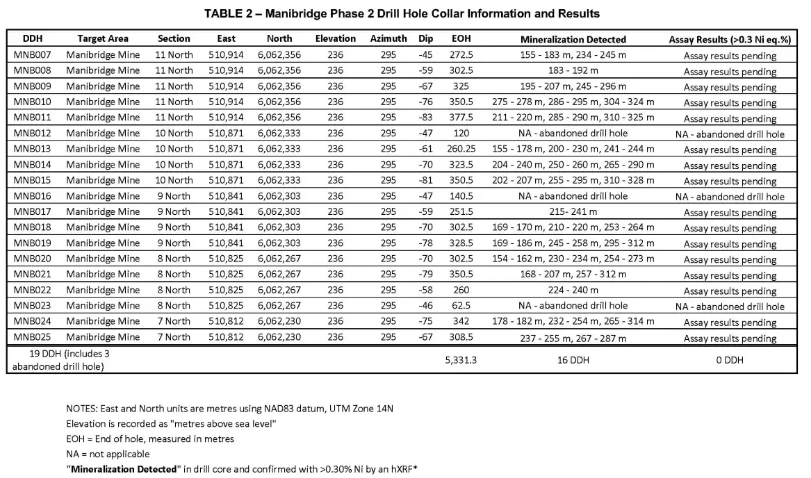
The above references an opinion and is for information purposes only. It is not intended to be investment advice. Seek a licensed professional for investment advice. The author is not an insider or shareholder of any of the companies mentioned above.
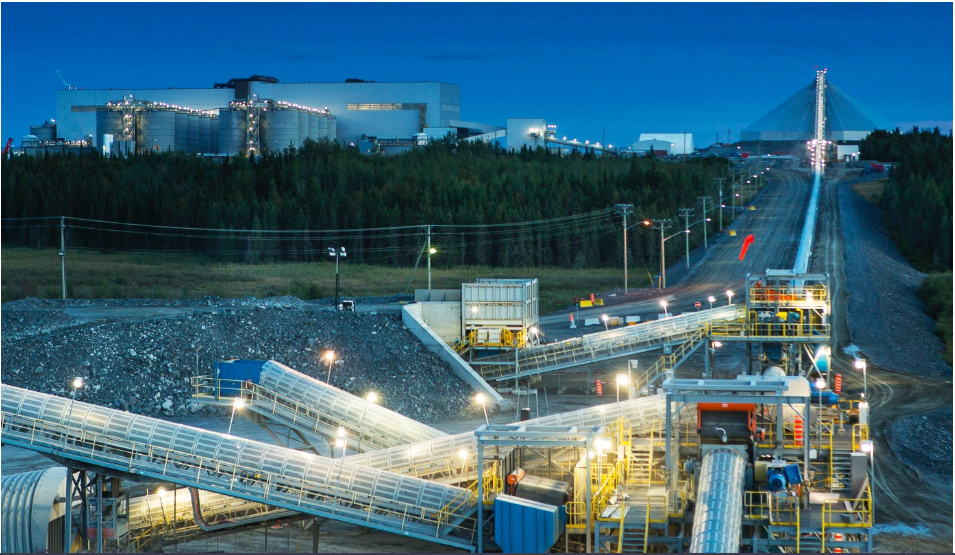
Pan American Silver (TSX:PAAS) and Agnico Eagle Mines (TSX:AEM) have agreed to buy Yamana Gold (TSX:YRI) in a $4.8 billion transaction including cash and shares. The deal was made on Tuesday after Gold Fields (NYSE:GFI) waived its right to match any rival bid on Monday.
The board recommended that shareholders reject the Gold Fields takeover at a vote on November 21. Gold Fields responded by noting that it is disappointed in the outcome: “We continue to believe that the transaction was a financially and strategically superior offer for shareholders of both Gold Fields and Yamana,” the company said.
Due to the lack of a deal with Gold Fields, Yamana will have to pay a $300 million break fee to Gold Fields since it has walked out of the deal just two business days before it was set to close. In a statement, Yunus Suleman, chair of Gold Fields said: “The emergence of another bid highlighted the value of [Yamana’s] assets and the need to respond to systemic strategic challenges facing the gold industry. However, we are disciplined in how we assess the value of assets and opportunities, and we were not prepared to be drawn into a bidding war which would have been value destructive for our shareholders.”
On Friday, Pan American and Agnico Eagle revealed the rival offer, which also which might split up Yamana’s assets in Canada and Latin America between the two companies. While the new deal is large, the previously considered Yamana-Gold Fields transaction would have made the fourth-largest gold miner in the world, passing even the value of Agnico Eagle.
Pan American will solidify its current position as a top precious metals producer in Latin America with this latest deal. For Agnico Eagle, the deal will mean consolidating ownership of the Canadian Malartic gold mine in Quebec, one of the world’s biggest.
Dealmaking has slowed in the mining industry this year, with this marking one of the biggest deals of the year. Gold mining companies have struggled to keep up with demand due to a variety of factors.
The first is declining gold grades across existing projects. This happens because as gold is mined, it becomes more difficult to extract and the amount of ore that can be mined per day decreases.
The second is the lack of new projects to replace ageing mines that are nearing the end of mine life. Costs have also risen, with companies spending more as extraction becomes more costly.
The third is the impact of China’s slowdown. China is the world’s second-largest consumer of precious metals, and its slowdown has had a ripple effect across the industry.
The above references an opinion and is for information purposes only. It is not intended to be investment advice. Seek a licensed professional for investment advice. The author is not an insider or shareholder of any of the companies mentioned above.
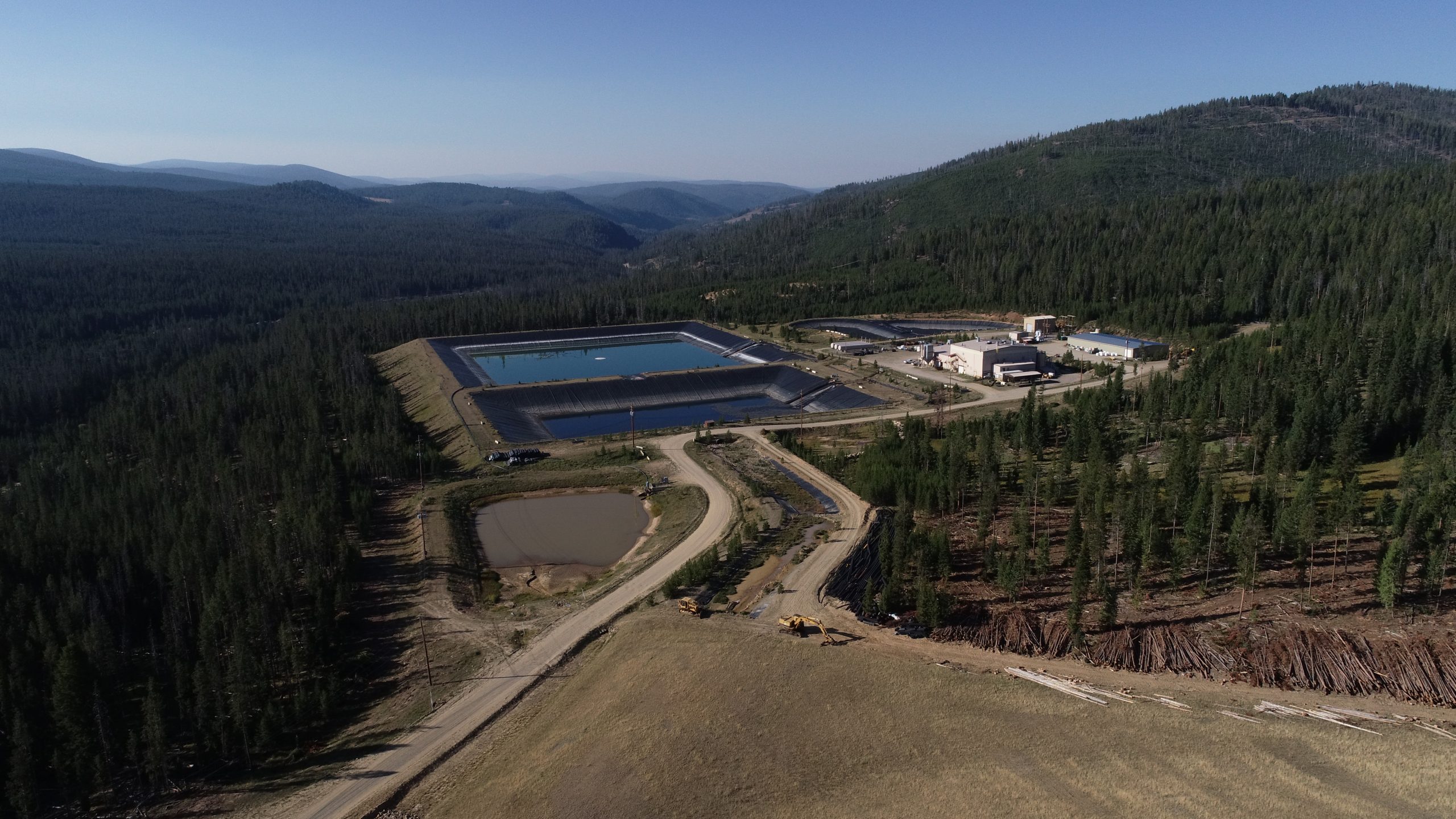
Revival Gold (TSXV:RVG) has concluded its 2022 drill program at the Beartrack-Arnett Gold Project in Idaho, USA. The program included 22 core holes for a total of approximately 5,500 metres. In September, results from the first two core holes from the 2022 program confined the continuity of potentially underground mineable grades within a broad zone of gold mineralization in the Joss target area and further emphasized the depth and scope of mineralization at Beartrack-Arnett.
The Joff target area extends over a strike of 1,000 metres, and has now been drilled to a depth of over 500 metres and is open in all directions. Intercepts for the 20 core holes completed at Joss to-date average 7.7 g/t gold over 5.5 meters drilled width within a broader zone of 2.8 g/t gold over 45.5 meters drilled width.
Hugh Agro, Revival Gold’s President & CEO, commented in a press release: “Revival Gold’s exploration team is to be commended for wrapping up another safe and productive drilling campaign at Beartrack-Arnett this year with exciting results from Joss and the completion of all planned drilling in the Haidee area to support next year’s PFS. Further assay results are expected later this month and into the new year. We look forward to building on 2022’s great results in the drilling campaigns to come.”
The company completed two more core hols this year for a total of four, and 2,600 metres on the main Beartrack-Arnett mineralization trend. One is in the South Pit target area and one more hole is in the Joss target area. Hole BT22-243D is intended to extend high-grade mineralization at the southern end of the South Pit and hole BT22-244D is intended to expand on high-grade intervals from the 2018 drilling program.
Revival Gold also completed 18 infill and expansion core holes for 2,900 metres in the near-surface, oxide material of the satellite deposit in the Haidee target area. The company intends these holes to upgrade the Inferred Resources to Indicated Resources. This would then extend the existing Mineral Resource to the southwest, or down-dip, direction. Assay results from Haidee may be available in the next three months, with mineralization at the site remaining open in all directions.
Currently, Revival is shifting exploration activities to the review and interpretation of drilling results. It would also update the Beartrack-Arnett geological and mineral resource models. This is aimed at supporting the planned 2023 first phase heap leach Preliminary Feasibility Study and any other plans the company will create for future drilling.
The above references an opinion and is for information purposes only. It is not intended to be investment advice. Seek a licensed professional for investment advice. The author is not an insider or shareholder of any of the companies mentioned above.
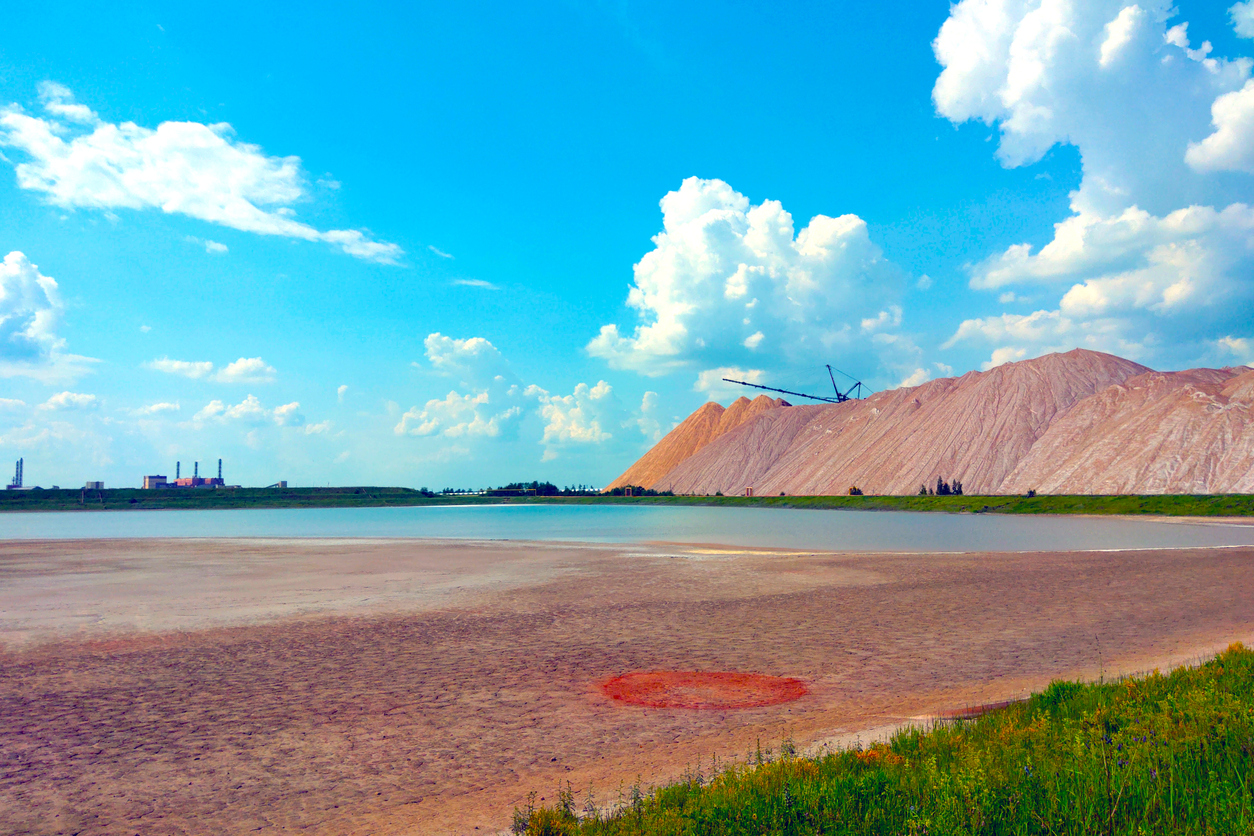
The mining industry is one of the leading innovators when it comes to green technologies and operations. As the world transitions to a greener, more renewable energy future with less reliance on fossil fuels, the mining industry is looking for cleaner, more sustainable alternatives in some operational practices.
One of the most promising clean mining technologies is called “sustainable mining”. Sustainable mining is a mining method that reduces the environmental impact of mining operations by using methods that minimise the use of water, energy and land.
A prime example of this is Brazil Potash’s Autazes Project, which is a clear sustainable engineering investment that will produce potassium chloride, an extremely important fertilizer.
The project will employ a process for extracting Sylvinite, a rock made up of halite (salt) and Sylvite, or Sylvine (potassium chloride), which will not harm the earth’s surface soil or environment. The chambers and pillars technique will be utilized throughout the entire extraction operation. In order to remove the ore, which is approximately 800 meters deep, the company will need to excavate two shafts. The Sylvinite ore will be brought to the surface through these wells, and processed so that the Potassium Chloride (fertilizer) can be separated from the Sodium Chloride (kitchen salt).
Companies are learning to manage operations in a more sustainable way out of necessity, but are driving innovation much faster than other industries out of motivation. That means making a few specific areas more efficient.
Tailings
This is the process during which the mining company removes the tailings from the beneficiation process by putting them into tailings piles. Tailings piles can be a major environmental issue because they can accumulate sediments and pollute water supplies.
There are now many companies looking for ways to clean up their tailings without releasing harmful toxins into the environment. One promising alternative is called filtration. Filtration allows Brazil Potash to stockpile the table salt in sealed piles. Latter the salt will return to the empty rooms in the underground.
Technology
Technology has played an important role in the development of sustainable mining methods. Some of the most important advances include:
-Remote sensing: Remote sensing is the use of technology to collect data about the environment without being physically present. This technology can be used to identify and monitor environmental issues such as water pollution and air quality, and help to plan and implement sustainable mining operations
-Augmented reality: Augmented reality is a technology that allows users to see information about the environment surrounding them in a more tangible way. This technology can be used to help plan and monitor sustainable mining operations, and to understand the impact of mining on the environment.
-Robotics: Robotics allows machines to be controlled and operated using software. Robotics has been used in many different industries, but is especially suited for the mining industry because it can help to automate repetitive tasks and improve safety.
Transportation
Of course one of the biggest emissions sources in any industry has historically been transportation. The mining industry has responded to this challenge by developing more sustainable transportation methods.
Some of the most promising transportation alternatives for the mining industry include:
-Electric vehicles: Electric vehicles are vehicles that use electric power to move. They have many benefits, including the fact that they produce little to no emissions.
-Self-driving trucks: While self-driving cars have been slow to hit the market, the mining industry is implementing self-driving trucks faster than ever. These trucks can navigate faster and better than human drivers, and can help to reduce the amount of time that is spent transporting goods.
They can also handle repeat routes in forward and reverse gears, saving time for turning around in tight spots for some projects.
As the world transitions to a more sustainable future, the mining industry is leading the way in developing cleaner, more sustainable alternatives. These technologies have the potential to reduce the environmental impact of mining operations, and help to restore degraded ecosystems. For companies like Brazil Potash bringing a more sustainable world forward through potash, a critical mineral for fertilizer, leading the way with its operations is a prime example of how the mining industry continues to innovate and put forward the ideas of the future.
The above references an opinion and is for information purposes only. It is not intended to be investment advice. Seek a licensed professional for investment advice. The author is not an insider or shareholder of any of the companies mentioned above.
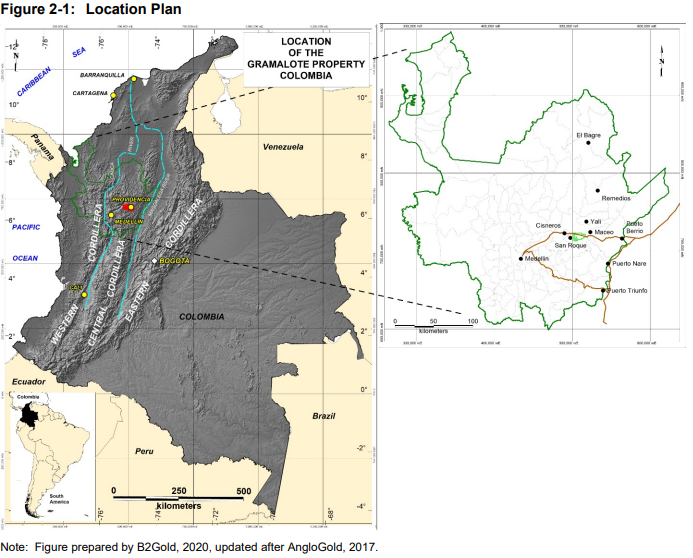
AngloGold Ashanti (NYSE:AU) and B2Gold (TSX:BTO) have put the $925 million Gramalote Colombian gold project on track to go up for sale by the end of the year. The companies reviewed alternatives for the project located in the northeastern department of Antioquia, but decided that it is in all stakeholders’ best interest to sell the project. This was noted in a third-quarter results report from B2Gold.
In August, the project was put on hold due to preliminary results from an optimized feasibility study suggesting that the project didn’t meet the joint venture’s investment thresholds. This meant the project could not be advanced to mine development. With the study completed, divesting became the best option for both companies.
Feasibility studies aim to evaluate the economic viability of a project and suggest a path to mine development. However, without a successful study, projects lose their value over time and may end up costing more than projected to develop.
For AngloGold Ashanti, selling the company is also a preferred option. The sale could allow AngloGold to focus on bigger assets, primarily the Guebradona gold-copper project in Colombia, valued at $1.4 billion. After a refusal from the environmental regulator ANLA to reopen the application for an environmental license for the project due to lack of information, the company will resubmit in 2023.
The mine could also become the country’s largest copper development with an estimated production of 137 million pounds copper concentrate per year with a phase one mine life of 22 years. The company has shifted focus to from its home country to other mines in Australia, Ghana, and Latin America in recent years. This strategy comes as the industry in South Africa has continued to shrink with soaring costs, power cuts, and geological challenges creating too many headwinds for many miners to make projects economically feasible.
Copper exploration has come to the forefront as a priority for the industry as a green technology and energy transition continues to speed up. Copper is used for a wide range of applications from wiring and construction to automobiles, renewable energy, and new medical technologies.
The above references an opinion and is for information purposes only. It is not intended to be investment advice. Seek a licensed professional for investment advice. The author is not an insider or shareholder of any of the companies mentioned above.
GoGold Resources (TSX:GGD) has announced a second set of drill results at its Eagle concession containing the northern strike extension of the Main Deposit on the Los Ricos South property. The recent highlights add to previous results from the company at the project. New highlights include hole LRGAG-22-035, one of the strongest holes drilled to date in the Los Ricos district, which intercepted 21,580 g/t silver equivalent (“AgEq”) over 0.9m, contained within 11.5m of 3,047 g/t AgEq within a wider intercept of 110.6m of 388 g/t AgEq.
President and CEO of GoGold Brad Langille commented in a press release: “Drilling along strike on the new Eagle concession continues to return exceptional results in both high grade and very wide widths. Today’s release of hole 35, along with hole 14 in our last release represent two of the best holes drilled in the Los Ricos district. With results like this, we are focussing the majority of our exploration on the new Eagle concession along with additional drill targets on the Main zone in Los Ricos South. Additional results are expected shortly.”
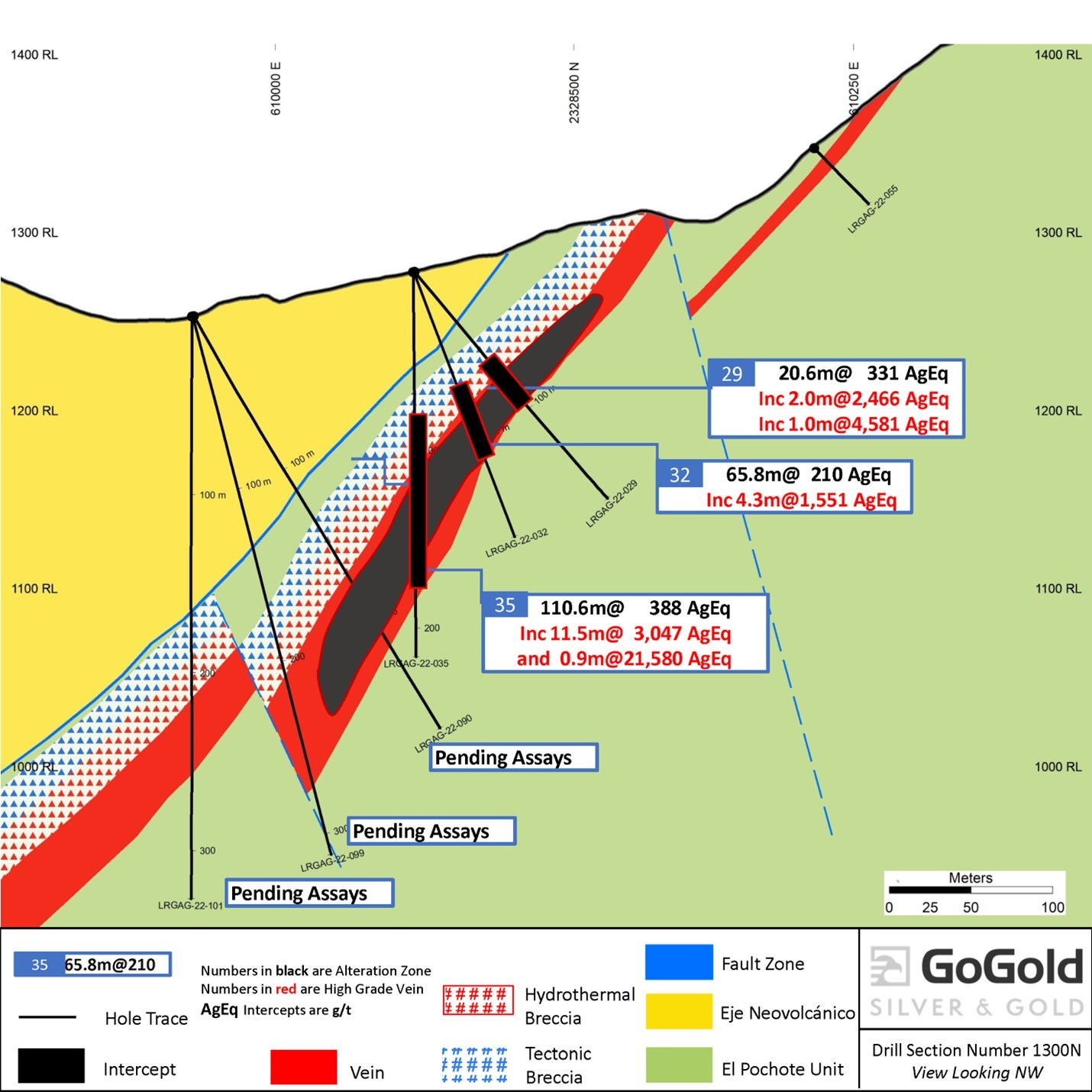
Table 1: Drill Hole Intersections
| Hole ID | Area / Vein | From | To | Length1 | Au | Ag | AuEq2 | AgEq2 |
| (m) | (m) | (m) | (g/t) | (g/t) | (g/t) | (g/t) | ||
| LRGAG-22-032 | Eagle | 48.1 | 113.8 | 65.8 | 1.36 | 107.7 | 2.79 | 209.6 |
| including | 85.8 | 113.8 | 28.1 | 2.96 | 216.6 | 5.85 | 439.0 | |
| including | 88.5 | 92.9 | 4.3 | 7.17 | 1,012.8 | 20.68 | 1,550.7 | |
| including | 88.5 | 89.1 | 0.6 | 25.00 | 3,020.0 | 65.27 | 4,895.0 | |
| LRGAG-22-033 | Eagle | 190.9 | 222.0 | 31.1 | 0.66 | 64.6 | 1.53 | 114.4 |
| including | 215.5 | 219.3 | 3.8 | 1.92 | 170.6 | 4.19 | 314.5 | |
| LRGAG-22-035 | Eagle | 69.0 | 179.6 | 110.6 | 1.64 | 264.6 | 5.17 | 387.5 |
| including | 129.0 | 140.5 | 11.5 | 11.31 | 2,198.3 | 40.62 | 3,046.7 | |
| including | 130.4 | 133.8 | 3.5 | 30.24 | 6,392.5 | 115.48 | 8,660.8 | |
| including | 130.4 | 131.9 | 1.5 | 63.24 | 12,729.3 | 232.96 | 17,472.0 | |
| including | 131.0 | 131.9 | 0.9 | 104.50 | 13,742.5 | 287.73 | 21,580.0 | |
| LRGAG-22-036 | Eagle | 87.0 | 128.0 | 41.0 | 1.26 | 83.9 | 2.38 | 178.5 |
| including | 109.0 | 128.0 | 19.0 | 2.11 | 143.8 | 4.02 | 301.8 | |
| including | 119.5 | 120.9 | 1.5 | 9.00 | 509.3 | 15.79 | 1,184.3 | |
| including | 119.5 | 120.3 | 0.8 | 12.55 | 782.0 | 22.98 | 1,723.3 | |
| LRGAG-22-037 | Eagle | 122.2 | 167.8 | 45.7 | 0.82 | 69.9 | 1.76 | 131.7 |
| including | 146.4 | 155.0 | 8.7 | 3.44 | 200.5 | 6.11 | 458.3 | |
| including | 149.9 | 151.6 | 1.7 | 12.95 | 181.7 | 15.37 | 1,152.6 | |
| including | 150.9 | 151.6 | 0.7 | 26.00 | 115.0 | 27.53 | 2,065.0 | |
| LRGAG-22-038 | Eagle | 88.0 | 124.0 | 36.0 | 1.30 | 75.7 | 2.31 | 173.0 |
| including | 106.9 | 116.0 | 9.2 | 4.81 | 256.1 | 8.23 | 616.9 | |
| including | 108.4 | 109.6 | 1.3 | 6.76 | 1,271.6 | 23.72 | 1,778.9 | |
| including | 108.4 | 109.0 | 0.7 | 7.70 | 2,030.0 | 34.77 | 2,607.5 | |
| also including | 112.6 | 115.0 | 2.4 | 12.64 | 163.6 | 14.82 | 1,111.7 | |
| including | 114.2 | 115.0 | 0.8 | 31.60 | 70.0 | 32.53 | 2,440.0 | |
| LRGAG-22-039 | Eagle | 149.7 | 169.0 | 19.4 | 0.93 | 65.8 | 1.81 | 135.7 |
| including | 156.8 | 164.4 | 7.6 | 1.87 | 145.0 | 3.81 | 285.6 | |
| including | 158.0 | 163.4 | 5.4 | 2.37 | 168.9 | 4.62 | 346.6 |
| 1. | Not true width |
| 2. | AqEq converted using a silver to gold ratio of 75:1 at recoveries of 100% |
| 3. | Hole LRGAG-22-034 did not intercept significant mineralization |
The Eagle concession adjoins the Main Deposit where the Los Ricos South Preliminary Economic Assessment (“PEA”) was released on January 20, 2021. This represents an extension to this previously defined Mineral Resource Estimate at Los Ricos South. The concession covers 1,107 hectares, including the area between the Main Deposit and the Company’s Jamaica concession located 3km to the northwest, where the Company holds the rights to additional concessions. Due diligence drilling has returned the highest grade intercepts to date in the district. These wide high grade intercepts are consistent with geophysical targets on the new concession. See Figure 1 below which shows a cross section including drill hole LRGAG-22-035.
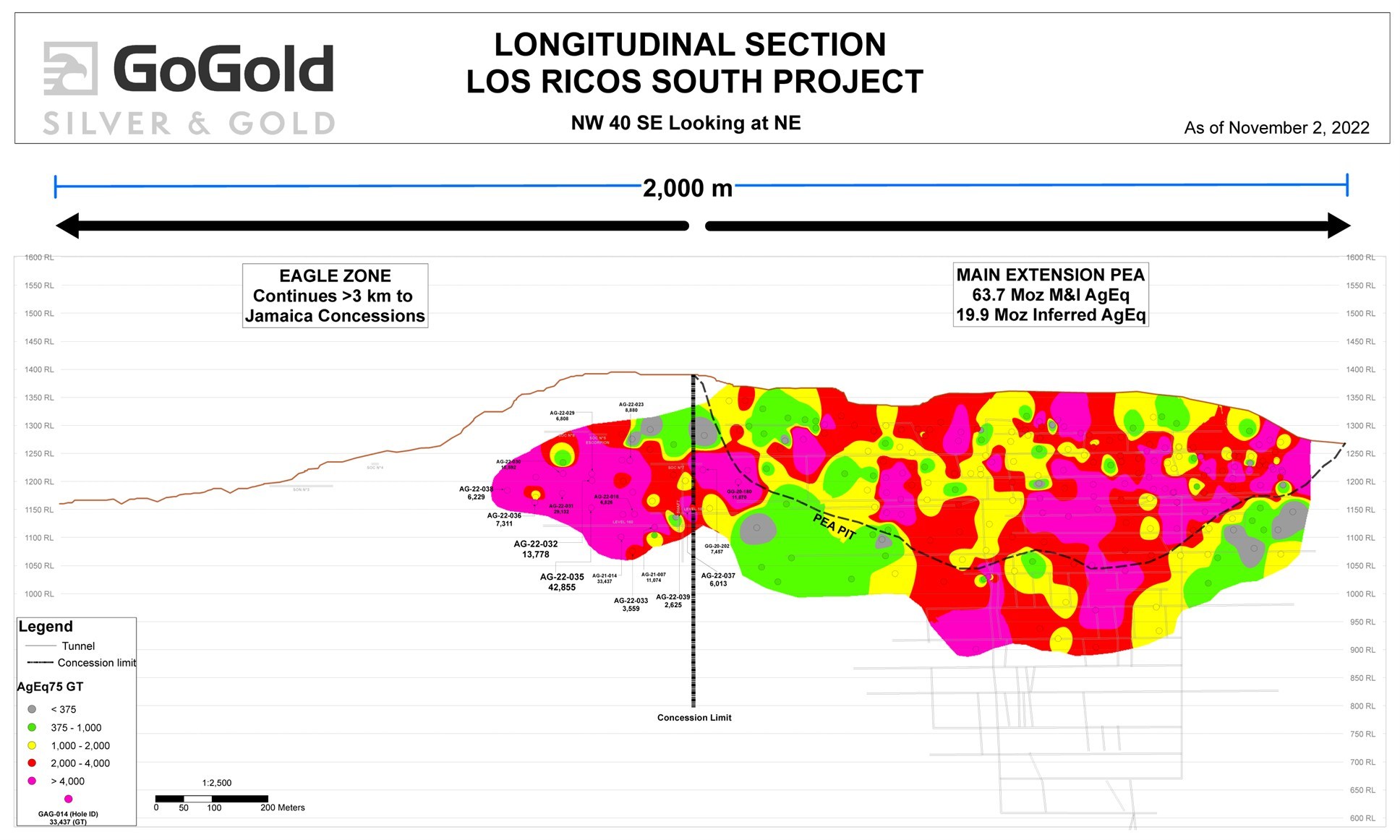
The Company has completed preliminary geological mapping, sampling, geophysical IP surveying, and has commenced a drill program at the Eagle. Mapping and geophysics indicate the Eagle structure extending in excess of 2.5km to the northwest, at which point it continues onto the Company’s previously owned Jamaica concessions. The Main Area was included in the initial Los Ricos South Mineral Resource estimate released on July 29, 2020, which included 1.1 km along strike of the mineralized trend.
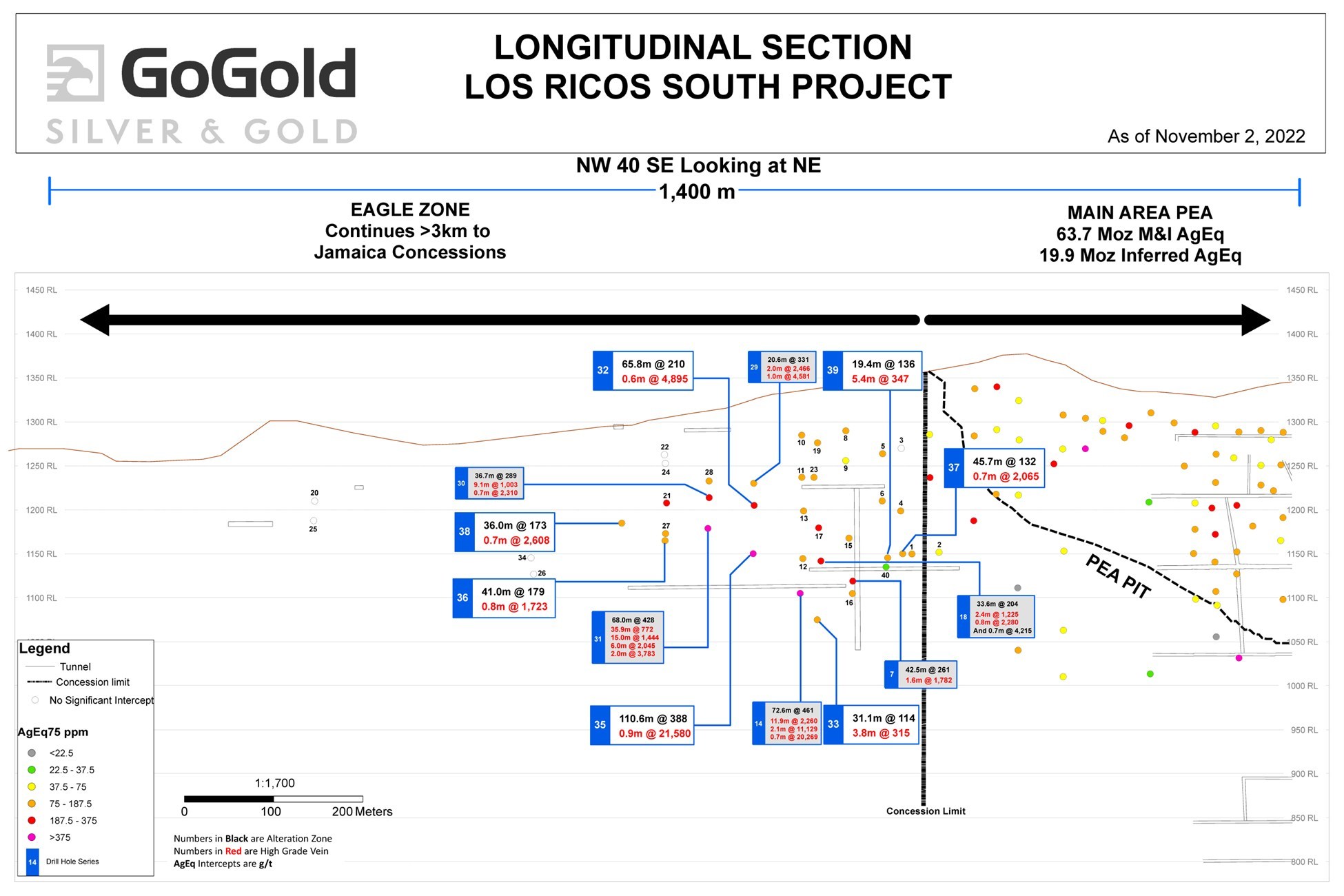
While there was some historical underground mining development in the early 1900’s on the Eagle concession, there was only one historical void encountered during drilling, which suggest that the mineralization at the Eagle may be intact and not previously mined. The location and high grade intercepts may indicate the presence of a high grade ore shoot that was not previously exploited. This differs from the Main Area which has had portions of it’s high grade ore shoots mined out.
The results of the sampling and geophysical IP survey (Figure 4) appear to indicate that the mineralized structure continues in a Northerly direction from the Main Area. Significant geophysical anomalies were identified which will form targets for the drilling campaign.
The Eagle concession connects the Company’s concessions held in the southern portion of its Los Ricos South project, including the Main area where the Initial Resource was released, to its northern concessions in Los Ricos South, which includes the Jamaica exploration target. As a result, all of the concessions in Los Ricos South are now contiguous (Figure 5).
The Company exploration team has been completing detailed mapping and sampling at Jamaica over the last year and sees the same structure that was drilled in the main zone at Los Ricos South extending for several kilometres over the Jamaica concessions. This offers the potential for an additional bulk tonnage target in Los Ricos South, with continuity from the Main Area and Eagle.
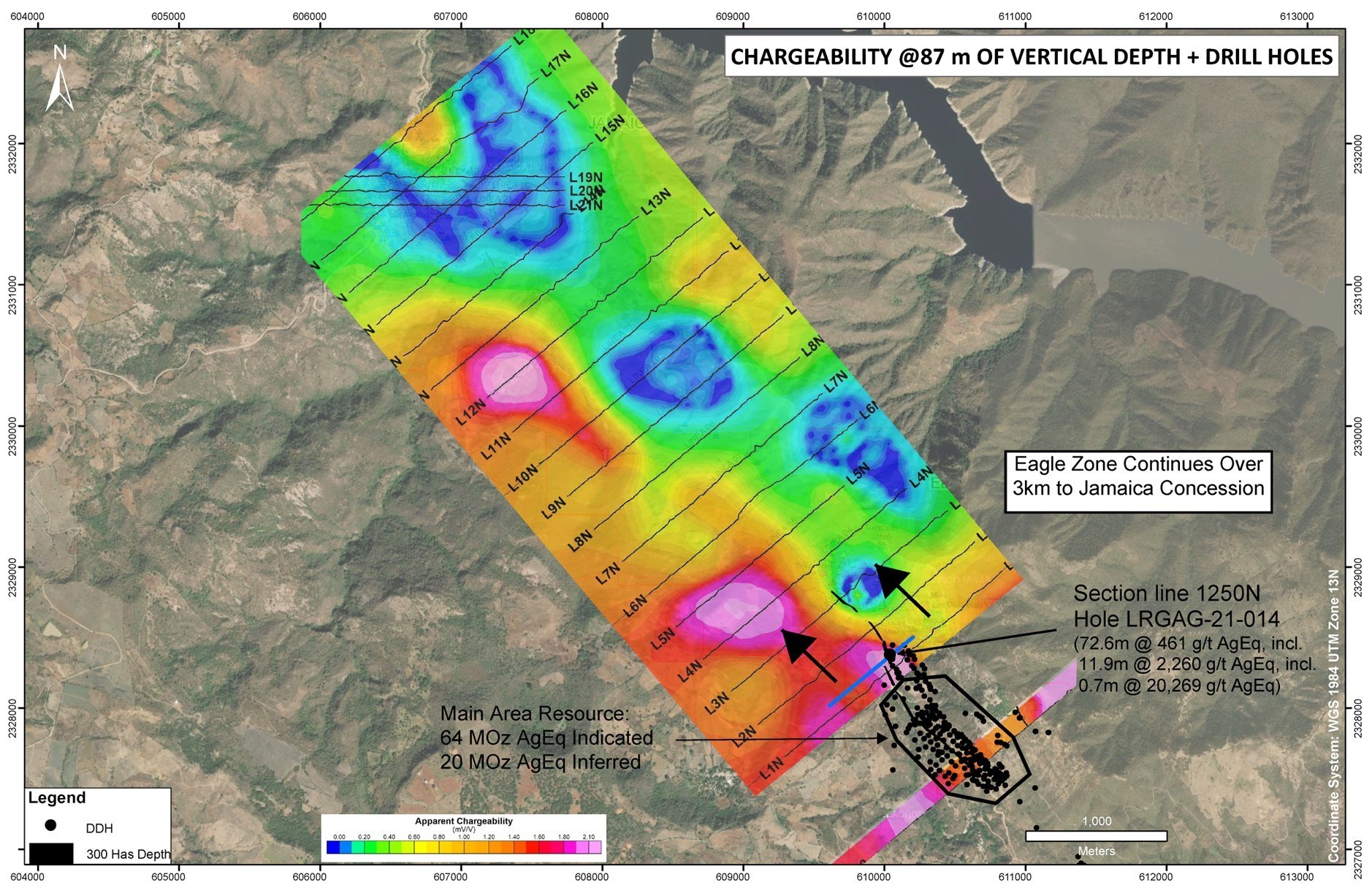
Table 2: Drill Hole Locations
| Hole ID | Easting | Northing | Elevation | Azimuth | Dip | Length |
| LRGAG-22-032 | 610059 | 2328444 | 1278 | 50 | -70 | 159 |
| LRGAG-22-033 | 610057 | 2328344 | 1283 | 0 | -90 | 295 |
| LRGAG-22-034 | 609857 | 2328604 | 1244 | 50 | -45 | 271 |
| LRGAG-22-035 | 610058 | 2328443 | 1278 | 0 | -90 | 216 |
| LRGAG-22-036 | 610026 | 2328548 | 1271 | 0 | -90 | 171 |
| LRGAG-22-037 | 610090 | 2328247 | 1295 | 0 | -90 | 213 |
| LRGAG-22-038 | 609977 | 2328575 | 1265 | 50 | -50 | 139 |
| LRGAG-22-039 | 610087 | 2328271 | 1289 | 50 | -65 | 219 |
The above references an opinion and is for information purposes only. It is not intended to be investment advice. Seek a licensed professional for investment advice. The author is not an insider or shareholder of any of the companies mentioned above.
Inflection Resources (CSE:AUCU) has provided an update to its ongoing exploration program in New South Wales, with the most recent drilling being focussed on the Duck Creek target. The company has intercepted a strong porphyry-style alteration and is now drill testing a series of copper-gold alkalic porphyry targets in the covered, northern extension of the Macquarie Arc.
The Duck Creek project includes a principal target area of 4.5 x 5.0 kilometres covering favourable magnetic and gravity features. At this time, Inflection is interpreting this to be a part of the Macquarie Arc volcanic sequence, with the broader target area comprising a large 10 x 15-kilometre gravity low embayment within the large regional magnetic high. The company is currently drill testing high-amplitude, complex, curvilinear magnetic patterns very similar to those typical of the intrusion-related signatures of the Macquarie Arc mineralized districts.
Drilling to-date has intersected strongly hydrothermally altered rocks, which are similar to those adjacent to mineralized alkalic copper-gold systems found at the Northparkes mine complex and Newcrest’s Cadia mine.
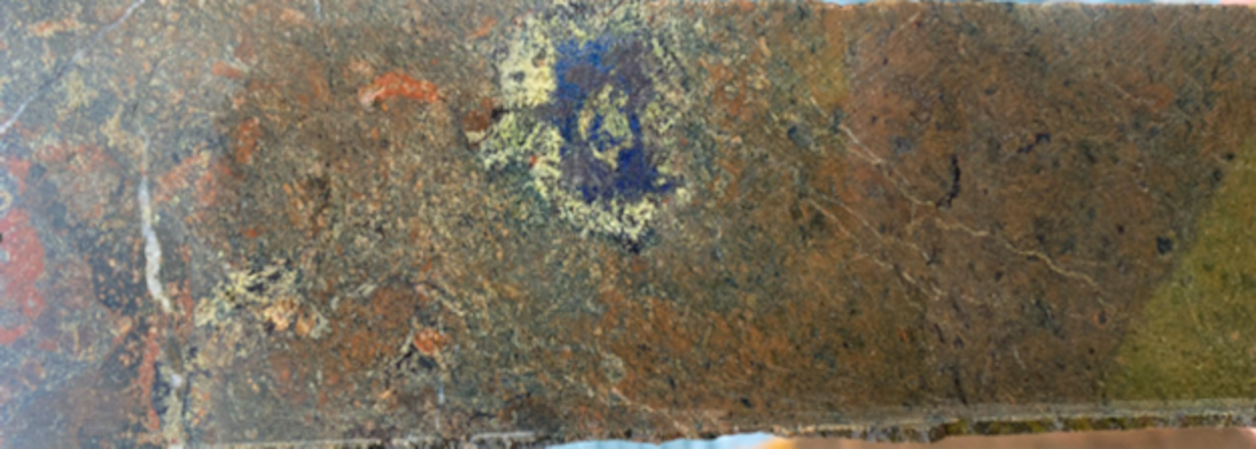
Alistair Waddell, Inflection’s President and CEO, commented in a press release: “We are very encouraged with the additional drill results at Duck Creek, which expand the alteration footprint and our understanding of the geological environment. Based on these results the Company interprets that recent drilling has intersected the upper parts of an alkalic porphyry system. We are excited to continue the drilling at Duck Creek and initiate the first deep diamond drill holes in the vicinity of holes DCKDH002, 005 and 006 to test for a potential mineralized centre of this large, complex hydrothermal system.”
Highlights from the update are as follows:
- The Company has completed three additional drill holes on the Duck Creek target where the Company previously reported favourable porphyry-style alteration from the first two holes;
- Drill holes DCKDH005 and DCKDH006 intercepted porphyry-style alteration similar to that found in the previously reported hole DCKDH002 extending the zone of favourable alteration over an approximate 400 by 250 metre area;
- Based on detailed modeling of geochemistry and mineralogy the Company will now target mineralisation at Duck Creek with a campaign of deeper diamond core drilling. The first priority target area is around the recent cluster of shallow drill holes DCKDH002, 005 and 006 that display strong alteration the Company interprets to be indicative of the upper parts of an alkalic copper-gold porphyry system. The principal target area of interest is associated with an 800 by 1,300 metre aeromagnetic low feature interpreted to represent magnetite destruction associated with hydrothermal alteration; and,
- An extended period of extremely wet weather, creating flood conditions, continues to impact most of eastern Australia and has limited access to the New South Wales project area including the Duck Creek drill platforms. Drilling is currently on-hold but will immediately recommence once the period of wet weather over the area comes to an end and the unpaved access roads dry out.
- The Company has completed an additional three drill holes, DCKDH004, 005 and 006, testing a variety of different targets in the vicinity of the previously reported holes DCKDH002 and 003 which returned strong porphyry-style hydrothermal alteration (see Inflection news release dated June 13, 2022).
- Drill hole DCKDH005 was a 405 metre deep -80º inclined hole drilled 225 metres to the southwest of hole DCKDH002 and intersected porphyritic andesitic volcanics with high-K calc-alkaline to shoshonitic affinities. These units exhibit feldspar-sericite-tourmaline-actinolite-pyrite alteration considered geologically analogous to that often seen in the upper parts of alkalic porphyry systems including Newcrest Mining’s Cadia East deposit. Centimetre scale blebs of bornite were intercepted at approximately 395 metres interpreted to be scavenged from earlier forming bornite veins and remobilised by later intrusive phases (Figure 1).
- Drill hole DCKDH006 is a -80º inclined hole drilled 380 metres west of hole DCKDH002 to a depth of 420 metres. The hole intersected polymictic volcaniclastics with patchy K-feldspar, quartz-epidote-chlorite-carbonate-pyrite-tourmaline alteration with disseminated actinolite. Assay results are anomalous for copper with values up to 771 ppm in holes DCKDH005 and 006 and are within the range of values expected in the upper parts of alkalic copper-gold porphyry systems located elsewhere in the Macquarie Arc.
- Drill hole DCKDH004 is a -80º inclined hole drilled into a separate target located approximately four kilometres to the southeast of hole DCKDH002. Drilling tested a large magnetic low interpreted to represent zones of magnetite depletion. The hole intersected andesitic volcaniclastics with moderate epidote-chlorite-minor hematite alteration. Weak alteration and geochemistry imply this specific target area has low potential and no further work is planned.
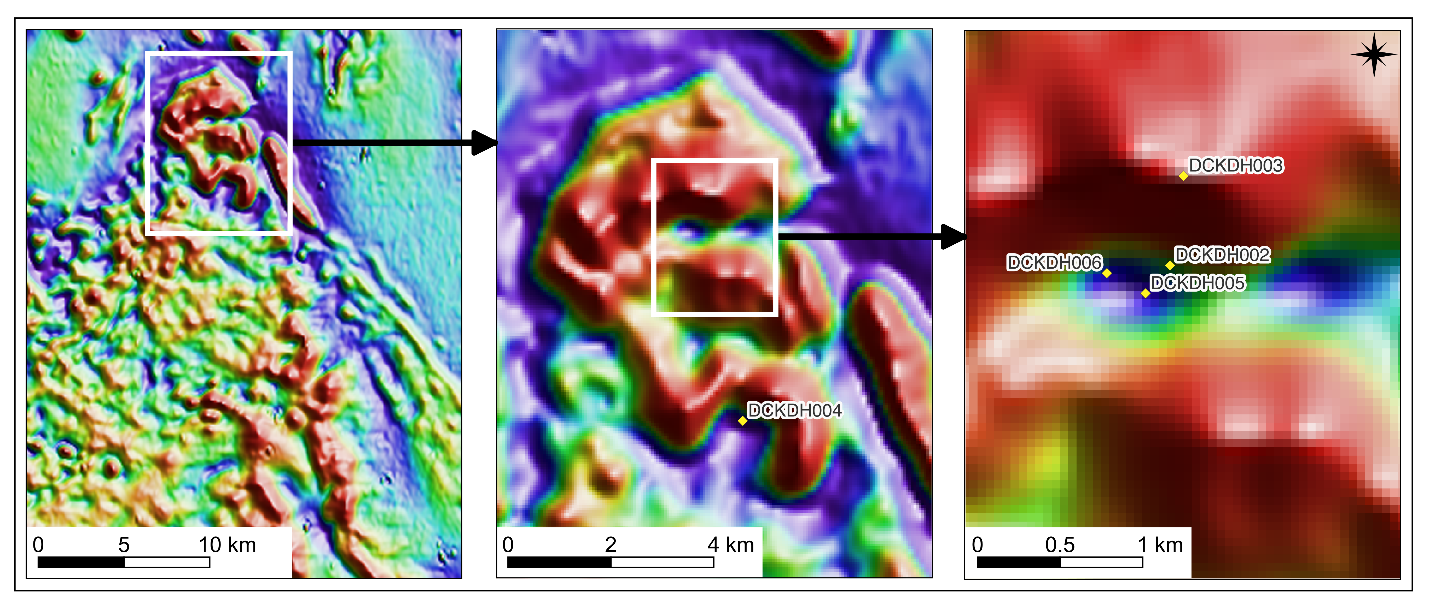
The above references an opinion and is for information purposes only. It is not intended to be investment advice. Seek a licensed professional for investment advice. The author is not an insider or shareholder of any of the companies mentioned above.
If you would like to receive our free newsletter via email, simply enter your email address below & click subscribe.
CONNECT WITH US
Tweets
Tweet with hash tag #miningfeeds or @miningfeeds and your tweets will be displayed across this site.
MOST ACTIVE MINING STOCKS
Daily Gainers
 Lincoln Minerals Limited Lincoln Minerals Limited |
LML.AX | +125.00% |
      |
GCR.AX | +33.33% |
      |
CASA.V | +30.00% |
      |
AHN.AX | +22.22% |
      |
ADD.AX | +22.22% |
      |
AZM.V | +21.98% |
      |
NSE.V | +21.05% |
      |
DYG.V | +18.42% |
      |
AAZ.V | +18.18% |
      |
GLA.AX | +17.65% |


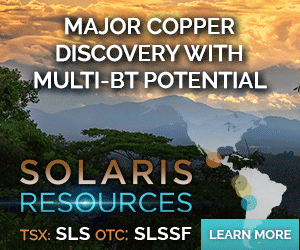
 Follow us on Twitter
Follow us on Twitter Become our facebook fan
Become our facebook fan








